Paul van Yperen's Blog, page 446
August 29, 2013
Valeska Gert
For Jan.
Jewish cabaret artist Valeska Gert (1892-1978) became famous in Berlin with her radical modern dances. With her dark, aquiline features. she was also active as an artists' model and appeared in several classics of the Weimar Cinema. After a comeback in Fellini’s Giulietta degli spiriti/Juliet of the Spirits (1965), Gert worked with the film makers of the New German Cinema of the 1970s.

German card. Photo: Atelier Leopold, München (Munich). Collection: Didier Hanson.
Dadaist Mixed Media Art Nights
Valeska Gert was born as Gertrud Valesca Samosch in 1892 in Berlin to a Jewish family. She was the eldest daughter of manufacturer Theodor Samosch and Augusta Rosenthal.
Exhibiting no interest in academics or office work, Gert began taking dance lessons at the age of nine. This, combined with her love of ornate fashion, was the basis for her career in dance and performance art.
In 1915, she studied acting with Maria Moissi.
World War I had a negative effect on her father’s finances, forcing Gert to rely on herself far more than other bourgeois daughters typically might. As World War I raged on, Gert joined a Berliner dance group and created revolutionary satirical dance.
In 1916, Gert made her dance debut in a Berlin film house, performing between film reels. The same year, she began acting at the Munich Kammerspiele.
Following engagements at the Deutsches Theater and the Tribüne in Berlin, Gert was invited to perform in expressionist plays in Dadaist mixed media art nights. Her performances in Oskar Kokoschka’s Hiob (1918), Ernst Toller’s Transformation (1919), and Frank Wedekind’s Franziska earned her popularity.
During this time, she also performed in the Schall und Rauch cabaret. Gert launched a tour of her own dances, with titles like Dance in Orange, Boxing, Circus, Japanese Grotesque, Death, and Whore. With her highly athletic style of dance, she created a sensation.
She also contributed articles for magazines like Die Weltbühne and the Berliner Tageszeitung.
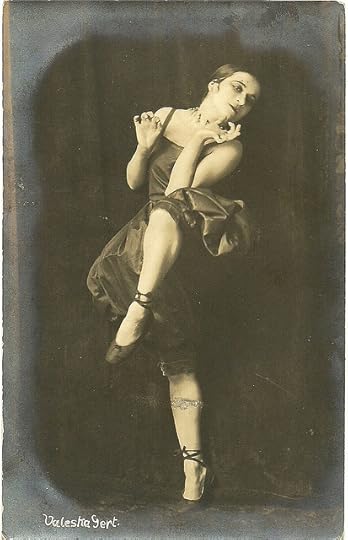
German card. Collection: Didier Hanson.
A Social Conscience Melodrama
By 1923, Valeska Gert focused her work more on film acting than live performance.
She played Puck in the Ufa production Ein Sommernachtstraum/Wood Love (Hans Neumann, 1925). This adaptation of William Shakespeare's A Midsummer Night's Dream had an all-star cast including Werner Krauss , Alexander Granach en Hans Albers .
In 1925 she also appeared in the classic Die freudlose Gasse/Joyless Street (G. W. Pabst, 1925), starring Asta Nielsen and the young Greta Garbo in her second major role.
Craig Butler at AllMovie : “Street is not about any one person but about a time, a place and, above all, a society that was perilously divided into two very unequal parts. Director G.W. Pabst and scenarist Willy Haas have created a social conscience melodrama that is enormously powerful; it's manipulative at times, but there's such commitment behind it that most viewers won't mind. Pabst is excellent at exploring the bleakness and despair of the residents of the Street and contrasting it with the amorality and immorality of the upper classes, who think nothing of spreading false rumors that will destroy many but will increase their own already considerable wealth.”
Gert also performed in G. W. Pabst’s Tagebuch einer Verlorenen/Diary of a Lost Girl (G. W. Pabst, 1929), and Die 3-Groschen-Oper/The Threepenny Opera (G. W. Pabst, 1931), loosely based on the 1928 musical theatre success The Threepenny Opera by Bertolt Brecht and Kurt Weill.
Gert played Mrs. Peachum, and according to Hal Erickson at AllMovie the film version “is every bit as good as the stage original, and sometimes even better.”
In France she appeared in Jean Renoir’s second film Nana (1926), a lavishly appointed adaptation of Emile Zola's novel. Other classic silent films with her were the science fiction horror film Alraune/Mandrake (Henrik Galeen, 1928) featuring Brigitte Helm , and Menschen am Sonntag/People on Sunday (Robert Siodmak, Rochus Gliese, Edgar G. Ulmer, 1930), based on a screenplay by Billy Wilder.
In the late twenties, Gert returned to the stage with pieces emphasizing Tontänze (sound dances), which explored the relationship between movement and sound.
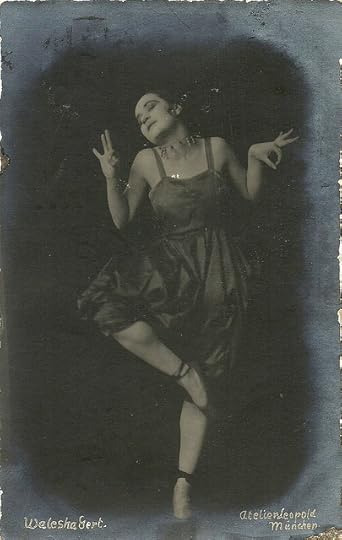
German card. Photo: Atelier Leopold, München (Munich). Collection: Didier Hanson.
Exile
In 1933, Valeska Gert’s Jewish heritage resulted in her ban from the German stage. Her exile from performance in Germany sent her to London for some time, where she worked both in theatre and film.
In London she worked on the experimental short film Pett and Pot (Alberto Cavalcanti, 1934), which would long stand as her last film.
In 1936, Gert wed an English writer, Robin Hay Anderson. It was her second marriage and her first husband had been Helmuth von Krause.
In 1938, she emigrated to the United States, where it was difficult for her to continue her previous career. She lived on the welfare of a Jewish refugee community and found work washing dishes and sometimes posing as a nude model.
This same year, she hired the 17-year old Georg Kreisler as a rehearsal pianist to continue focus on cabaret work.
By 1941, she had opened the Beggar Bar in New York, where Julian Beck, Judith Malina, and Jackson Pollock worked for her. Tennessee Williams also worked for her for a short time as a busboy, but was fired for refusing to pool his tips.
By 1944, Gert had relocated to Provincetown, Massachusetts, where she opened Valeska's. During this period, Gert was called to Provincetown court for throwing garbage out of her window and failing to pay a dance partner. She called upon Williams as a character witness, which he did with pleasure, despite the fact that she fired him. He told incredulous friends that he "simply liked her".
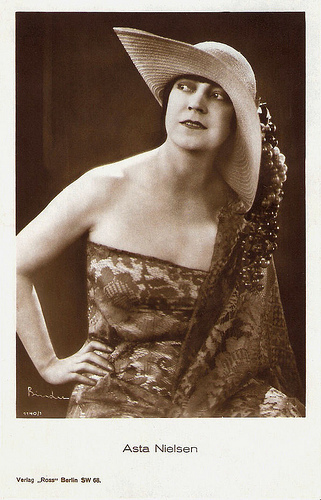
Asta Nielsen . German postcard by Ross Verlag, no. 1140/1, 1927-1928. Photo: Alex Binder, Berlin.
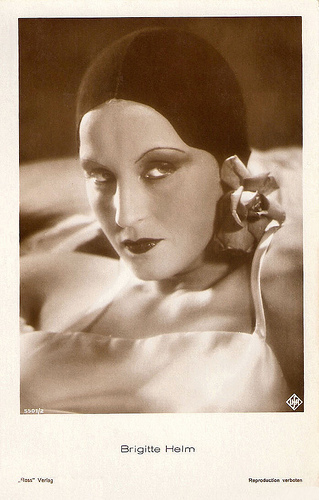
Brigitte Helm . German postcard by Ross Verlag, no. 5501/2, 1930-1931. Photo: Ufa. Distributed in Italy by Ballerini& Frattini, Florence.
Fellini and Fassbinder
In 1947 Valeska Gert returned to Europe. After stays in Paris and Zurich, she went to Blockaded Berlin in 1949, where she opened the cabaret Hexenküche (Witch's Kitchen) in the next year. Following Hexenküche, she opened Ziegenstall on the island of Sylt.
In the 1960s, she made her screen comeback. She was rediscovered by Federico Fellini who gave her a part in his film Giulietta degli spiriti/Juliet of the Spirits (1965), featuring Giulietta Masina .
The film brought her to the attention of a new generation of German directors. During the 1970s, she played in an episode of Rainer Werner Fassbinder's serial Acht Stunden sind kein Tag/Eight Hours are Not a Day (1973), the experimental film Die Betörung der blauen Matrosen/The Enchantment of the Blue Sailors (Tabea Blumenschein, Ulrike Ottinger, 1975) and in Volker Schlöndorff's Der Fangschuss/Coup de grâce (1976), with Matthias Habich.
Schlöndorff also made a documentary about her, Nur zum Spaß, nur zum/Just for fun, just for the game (1977). Gert told in this film about theatre in Berlin in the 1920s, and her dances were re-created by Pola Kinski.
In 1978 Werner Herzog invited Gert to play the real estate broker Knock in his remake of F.W. Murnau's classic film Nosferatu, but she died just two weeks later before filming began.
On 18 March 1978 neighbours and friends in Kampen, Germany, reported she had not been seen for four days. When her door was forced in the presence of police she was found dead. She was 86 years old.
In 1970. she had been awarded with the Filmband in Gold for lifelong achievement in German film.
Valeska Gert’s art was for the first time exhibited in 2010 in the Berlin Museum for Contemporary Art Hamburger Bahnhof.
Valeska Gert - Die Frau im Taumel des Lasters. Short scene from the documentary Cabaret Berlin - Die wilde Bühne 1919 - 1933. Source: dict adtv (YouTube)
Scene from Der Fangschuss/Coup de grâce (1976). Source: Matcarriere (YouTube).
Sources: Thomas Staedeli (Cyranos), Craig Butler (AllMovie), Hal Erickson (AllMovie), Wikipedia and .
Jewish cabaret artist Valeska Gert (1892-1978) became famous in Berlin with her radical modern dances. With her dark, aquiline features. she was also active as an artists' model and appeared in several classics of the Weimar Cinema. After a comeback in Fellini’s Giulietta degli spiriti/Juliet of the Spirits (1965), Gert worked with the film makers of the New German Cinema of the 1970s.

German card. Photo: Atelier Leopold, München (Munich). Collection: Didier Hanson.
Dadaist Mixed Media Art Nights
Valeska Gert was born as Gertrud Valesca Samosch in 1892 in Berlin to a Jewish family. She was the eldest daughter of manufacturer Theodor Samosch and Augusta Rosenthal.
Exhibiting no interest in academics or office work, Gert began taking dance lessons at the age of nine. This, combined with her love of ornate fashion, was the basis for her career in dance and performance art.
In 1915, she studied acting with Maria Moissi.
World War I had a negative effect on her father’s finances, forcing Gert to rely on herself far more than other bourgeois daughters typically might. As World War I raged on, Gert joined a Berliner dance group and created revolutionary satirical dance.
In 1916, Gert made her dance debut in a Berlin film house, performing between film reels. The same year, she began acting at the Munich Kammerspiele.
Following engagements at the Deutsches Theater and the Tribüne in Berlin, Gert was invited to perform in expressionist plays in Dadaist mixed media art nights. Her performances in Oskar Kokoschka’s Hiob (1918), Ernst Toller’s Transformation (1919), and Frank Wedekind’s Franziska earned her popularity.
During this time, she also performed in the Schall und Rauch cabaret. Gert launched a tour of her own dances, with titles like Dance in Orange, Boxing, Circus, Japanese Grotesque, Death, and Whore. With her highly athletic style of dance, she created a sensation.
She also contributed articles for magazines like Die Weltbühne and the Berliner Tageszeitung.

German card. Collection: Didier Hanson.
A Social Conscience Melodrama
By 1923, Valeska Gert focused her work more on film acting than live performance.
She played Puck in the Ufa production Ein Sommernachtstraum/Wood Love (Hans Neumann, 1925). This adaptation of William Shakespeare's A Midsummer Night's Dream had an all-star cast including Werner Krauss , Alexander Granach en Hans Albers .
In 1925 she also appeared in the classic Die freudlose Gasse/Joyless Street (G. W. Pabst, 1925), starring Asta Nielsen and the young Greta Garbo in her second major role.
Craig Butler at AllMovie : “Street is not about any one person but about a time, a place and, above all, a society that was perilously divided into two very unequal parts. Director G.W. Pabst and scenarist Willy Haas have created a social conscience melodrama that is enormously powerful; it's manipulative at times, but there's such commitment behind it that most viewers won't mind. Pabst is excellent at exploring the bleakness and despair of the residents of the Street and contrasting it with the amorality and immorality of the upper classes, who think nothing of spreading false rumors that will destroy many but will increase their own already considerable wealth.”
Gert also performed in G. W. Pabst’s Tagebuch einer Verlorenen/Diary of a Lost Girl (G. W. Pabst, 1929), and Die 3-Groschen-Oper/The Threepenny Opera (G. W. Pabst, 1931), loosely based on the 1928 musical theatre success The Threepenny Opera by Bertolt Brecht and Kurt Weill.
Gert played Mrs. Peachum, and according to Hal Erickson at AllMovie the film version “is every bit as good as the stage original, and sometimes even better.”
In France she appeared in Jean Renoir’s second film Nana (1926), a lavishly appointed adaptation of Emile Zola's novel. Other classic silent films with her were the science fiction horror film Alraune/Mandrake (Henrik Galeen, 1928) featuring Brigitte Helm , and Menschen am Sonntag/People on Sunday (Robert Siodmak, Rochus Gliese, Edgar G. Ulmer, 1930), based on a screenplay by Billy Wilder.
In the late twenties, Gert returned to the stage with pieces emphasizing Tontänze (sound dances), which explored the relationship between movement and sound.

German card. Photo: Atelier Leopold, München (Munich). Collection: Didier Hanson.
Exile
In 1933, Valeska Gert’s Jewish heritage resulted in her ban from the German stage. Her exile from performance in Germany sent her to London for some time, where she worked both in theatre and film.
In London she worked on the experimental short film Pett and Pot (Alberto Cavalcanti, 1934), which would long stand as her last film.
In 1936, Gert wed an English writer, Robin Hay Anderson. It was her second marriage and her first husband had been Helmuth von Krause.
In 1938, she emigrated to the United States, where it was difficult for her to continue her previous career. She lived on the welfare of a Jewish refugee community and found work washing dishes and sometimes posing as a nude model.
This same year, she hired the 17-year old Georg Kreisler as a rehearsal pianist to continue focus on cabaret work.
By 1941, she had opened the Beggar Bar in New York, where Julian Beck, Judith Malina, and Jackson Pollock worked for her. Tennessee Williams also worked for her for a short time as a busboy, but was fired for refusing to pool his tips.
By 1944, Gert had relocated to Provincetown, Massachusetts, where she opened Valeska's. During this period, Gert was called to Provincetown court for throwing garbage out of her window and failing to pay a dance partner. She called upon Williams as a character witness, which he did with pleasure, despite the fact that she fired him. He told incredulous friends that he "simply liked her".

Asta Nielsen . German postcard by Ross Verlag, no. 1140/1, 1927-1928. Photo: Alex Binder, Berlin.

Brigitte Helm . German postcard by Ross Verlag, no. 5501/2, 1930-1931. Photo: Ufa. Distributed in Italy by Ballerini& Frattini, Florence.
Fellini and Fassbinder
In 1947 Valeska Gert returned to Europe. After stays in Paris and Zurich, she went to Blockaded Berlin in 1949, where she opened the cabaret Hexenküche (Witch's Kitchen) in the next year. Following Hexenküche, she opened Ziegenstall on the island of Sylt.
In the 1960s, she made her screen comeback. She was rediscovered by Federico Fellini who gave her a part in his film Giulietta degli spiriti/Juliet of the Spirits (1965), featuring Giulietta Masina .
The film brought her to the attention of a new generation of German directors. During the 1970s, she played in an episode of Rainer Werner Fassbinder's serial Acht Stunden sind kein Tag/Eight Hours are Not a Day (1973), the experimental film Die Betörung der blauen Matrosen/The Enchantment of the Blue Sailors (Tabea Blumenschein, Ulrike Ottinger, 1975) and in Volker Schlöndorff's Der Fangschuss/Coup de grâce (1976), with Matthias Habich.
Schlöndorff also made a documentary about her, Nur zum Spaß, nur zum/Just for fun, just for the game (1977). Gert told in this film about theatre in Berlin in the 1920s, and her dances were re-created by Pola Kinski.
In 1978 Werner Herzog invited Gert to play the real estate broker Knock in his remake of F.W. Murnau's classic film Nosferatu, but she died just two weeks later before filming began.
On 18 March 1978 neighbours and friends in Kampen, Germany, reported she had not been seen for four days. When her door was forced in the presence of police she was found dead. She was 86 years old.
In 1970. she had been awarded with the Filmband in Gold for lifelong achievement in German film.
Valeska Gert’s art was for the first time exhibited in 2010 in the Berlin Museum for Contemporary Art Hamburger Bahnhof.
Valeska Gert - Die Frau im Taumel des Lasters. Short scene from the documentary Cabaret Berlin - Die wilde Bühne 1919 - 1933. Source: dict adtv (YouTube)
Scene from Der Fangschuss/Coup de grâce (1976). Source: Matcarriere (YouTube).
Sources: Thomas Staedeli (Cyranos), Craig Butler (AllMovie), Hal Erickson (AllMovie), Wikipedia and .
Published on August 29, 2013 23:00
August 28, 2013
Vanda Hudson
Beautiful starlet Vanda Hudson (1937-2004) was one of the blond bombshells of the British cinema in the post-war years. She appeared in a dozen films and TV series of the late 1950s and early 1960s.
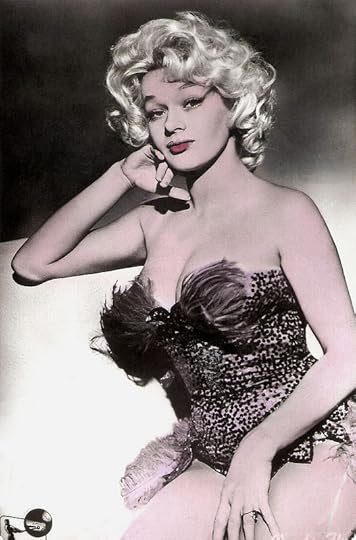
Yugoslavian postcard by Studio Sombor, no. 288. Photo: Rank.
Too Sexy For Blackpool
Vanda Hudson was born as Wanda Zaleska in Silesia, part of present-day Poland (some sources say Villefrance, France), in 1937. She moved to Great Britain in 1948 and made her screen debut in 1955. I could not find much more information about her private life on the web.
There is a 1958 press picture of her in a sexy dress in which she is presented as a cabaret singer. According to the subscript Vanda “joined the summer show on Blackpool's Central pier and brought along this gold Lame and sequin dress to wear in her act. But producer Peter Webster decided it was too sexy for Blackpool holiday makers so he ruled that the dress is out. Instead Vanda wears a less revealing simple styled dress to cover her 38-22-36 figure.”
A publicity stunt for the Central pier and for the blond bombshell?
Since the mid-1950s Vanda worked as an actress in films and TV series. According to IMDb, she made her TV-debut in 1955 in the British Detective series The Vipe (Richard Lester a.o., 1954-1960).
Her first film appearance was an uncredited part in the World War II drama Seven Thunders (Hugo Fregonese, 1957) starring Stephen Boyd.
More small parts followed in the drama Innocent Sinners (Philip Leacock, 1958), the Frankie Vaughan vehicle The Heart of a Man (Herbert Wilcox, 1959) in which she played a character called Cha Cha, and the Oscar nominated drama Libel (Anthony Asquith, 1959) starring Dirk Bogarde .
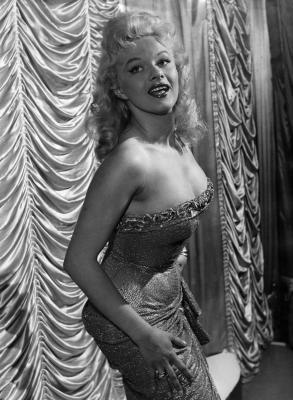
Press photo of Vanda Hudson in Blackpool in 1958. Source: Art 247.
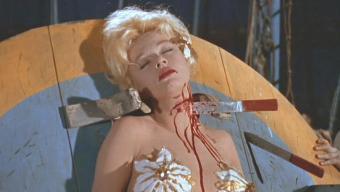
Vanda Hudson in Circus of Horrors (1960). Source: Cinemorgue.
Lurid And Risqué
In 1960 Vanda Hudson played a supporting part in the comedy Bottoms Up (Mario Zampi, 1960), just credited as Vanda.
That year she also appeared in the horror film Circus of Horrors (Sydney Hayers, 1960) starring Anton Diffring and German star Erika Remberg .
IMDb reviewer Guanche calls it “Lurid and risqué for its time, and still quite unsettling (…) This is a grim story of a doctor fleeing some botched plastic surgeries. He takes over a backwoods circus and populates it with beautiful, yet disfigured female performers whom he restores to beauty and rescues from lives of prostitution and rejection. Of course, once the circus becomes successful, the ladies no longer feel like putting up with, or putting out for him, so he devises elaborate circus ‘accidents’ to deal with their ingratitude.”
Vanda plays one of his victims, who meets a particularly gruesome end. Anton Diffring sabotages the knife-thrower's act and sexy target girl Magda von Meck (Vanda) is stabbed in the throat.

German postcard by ISV, no. 11/6.

Yugoslavian postcard by Studio Sombor, no. 288. Sent by mail in 1963. Photo: Rank.
Scandalous Luxemburg Production
Vanda Hudson’s biggest film role came the following year with her part as Fina in the romance Ticket to Paradise (Francis Searle, 1961), for which she was billed third.
More supporting parts followed in the crime films Jungle Street (Charles Saunders, 1961) starring David McCallum and Jill Ireland, and Strip Tease Murder (Ernest Morris, 1961) with Ann Lynn.
She then appeared in Double Danger (Roger Jenkins, 1961), an episode of the first season of the legendary mystery TV series The Avengers (1961-1969) starring Patrick Macnee as secret agent John Steed.
Vanda played a bit part in the comedy Father Came Too! (Peter Graham Scott, 1964) starring James Robertson Justice.
In 1963 she retired to raise her family but in 1967 she was seen in the scandalous Luxemburg production Happening (Marc Boureau, 1967) with André Dumas.
Two years later she appeared topless as an aspiring actress in the sex comedy A Promise of Bed (Derek Ford, 1969) with Victor Spinetti. It would be her final film.
Subsequently she ran the restaurant Turpin’s in Hampstead, north London.
Vanda Hudson died in 2004, aged 70.
Trailer of Circus of Horrors (1960). Source: Wicked Vision Magazine (YouTube).
Sources: The Stage, Cinemorgue, Screenweek, Art. 247 and .

Yugoslavian postcard by Studio Sombor, no. 288. Photo: Rank.
Too Sexy For Blackpool
Vanda Hudson was born as Wanda Zaleska in Silesia, part of present-day Poland (some sources say Villefrance, France), in 1937. She moved to Great Britain in 1948 and made her screen debut in 1955. I could not find much more information about her private life on the web.
There is a 1958 press picture of her in a sexy dress in which she is presented as a cabaret singer. According to the subscript Vanda “joined the summer show on Blackpool's Central pier and brought along this gold Lame and sequin dress to wear in her act. But producer Peter Webster decided it was too sexy for Blackpool holiday makers so he ruled that the dress is out. Instead Vanda wears a less revealing simple styled dress to cover her 38-22-36 figure.”
A publicity stunt for the Central pier and for the blond bombshell?
Since the mid-1950s Vanda worked as an actress in films and TV series. According to IMDb, she made her TV-debut in 1955 in the British Detective series The Vipe (Richard Lester a.o., 1954-1960).
Her first film appearance was an uncredited part in the World War II drama Seven Thunders (Hugo Fregonese, 1957) starring Stephen Boyd.
More small parts followed in the drama Innocent Sinners (Philip Leacock, 1958), the Frankie Vaughan vehicle The Heart of a Man (Herbert Wilcox, 1959) in which she played a character called Cha Cha, and the Oscar nominated drama Libel (Anthony Asquith, 1959) starring Dirk Bogarde .

Press photo of Vanda Hudson in Blackpool in 1958. Source: Art 247.

Vanda Hudson in Circus of Horrors (1960). Source: Cinemorgue.
Lurid And Risqué
In 1960 Vanda Hudson played a supporting part in the comedy Bottoms Up (Mario Zampi, 1960), just credited as Vanda.
That year she also appeared in the horror film Circus of Horrors (Sydney Hayers, 1960) starring Anton Diffring and German star Erika Remberg .
IMDb reviewer Guanche calls it “Lurid and risqué for its time, and still quite unsettling (…) This is a grim story of a doctor fleeing some botched plastic surgeries. He takes over a backwoods circus and populates it with beautiful, yet disfigured female performers whom he restores to beauty and rescues from lives of prostitution and rejection. Of course, once the circus becomes successful, the ladies no longer feel like putting up with, or putting out for him, so he devises elaborate circus ‘accidents’ to deal with their ingratitude.”
Vanda plays one of his victims, who meets a particularly gruesome end. Anton Diffring sabotages the knife-thrower's act and sexy target girl Magda von Meck (Vanda) is stabbed in the throat.

German postcard by ISV, no. 11/6.

Yugoslavian postcard by Studio Sombor, no. 288. Sent by mail in 1963. Photo: Rank.
Scandalous Luxemburg Production
Vanda Hudson’s biggest film role came the following year with her part as Fina in the romance Ticket to Paradise (Francis Searle, 1961), for which she was billed third.
More supporting parts followed in the crime films Jungle Street (Charles Saunders, 1961) starring David McCallum and Jill Ireland, and Strip Tease Murder (Ernest Morris, 1961) with Ann Lynn.
She then appeared in Double Danger (Roger Jenkins, 1961), an episode of the first season of the legendary mystery TV series The Avengers (1961-1969) starring Patrick Macnee as secret agent John Steed.
Vanda played a bit part in the comedy Father Came Too! (Peter Graham Scott, 1964) starring James Robertson Justice.
In 1963 she retired to raise her family but in 1967 she was seen in the scandalous Luxemburg production Happening (Marc Boureau, 1967) with André Dumas.
Two years later she appeared topless as an aspiring actress in the sex comedy A Promise of Bed (Derek Ford, 1969) with Victor Spinetti. It would be her final film.
Subsequently she ran the restaurant Turpin’s in Hampstead, north London.
Vanda Hudson died in 2004, aged 70.
Trailer of Circus of Horrors (1960). Source: Wicked Vision Magazine (YouTube).
Sources: The Stage, Cinemorgue, Screenweek, Art. 247 and .
Published on August 28, 2013 23:00
August 27, 2013
Else Bötticher
In the early 20th century, German actress Else Bötticher (1880-1966) performed with famous stage stars in international theatres. During the 1910s, she made several silent films. In the sound era, she returned to the cinema but then only played small roles as wives and mothers.
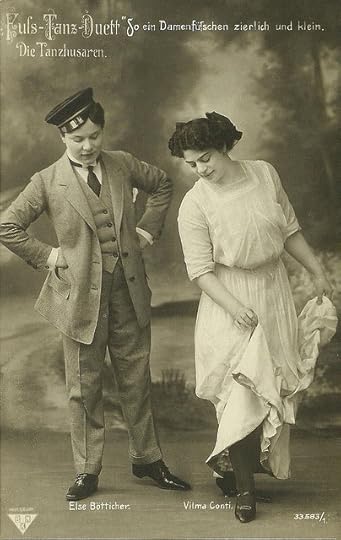
With Vilma Conti. German postcard by BNK, no. 33 583/1. Collection: Didier Hanson.
Caption: "Fuss-Tanz-Duett. So ein Damesfüsschen zierlich und klein. Die Tanzhusaren" (Foot-dance duet. Such a dainty and small lady foot. The Dance Hussars).
Acting Greats
Else Bötticher began her career at age 18 in the province. Then she played for two years Nora in theatres in the US.
Back in Germany, she was a partner of such acting greats as Josef Kainz and Max Pallenberg.
Max Reinhardt engaged her several times for his guest directions in Munich. Bötticher also repeatedly did guest performances in the Netherlands, Switzerland, Belgium, and France.
However, she worked mainly in German theatres such as the Königlichen Hoftheater zu Stuttgart (Royal Court Theatre in Stuttgart) and especially, since shortly before the First World War, in Berlin theatres such as the Trianon-Theater.
In the later years of the Weimar Republic, she was seen at the Neues Theater am Zoo and other stages.
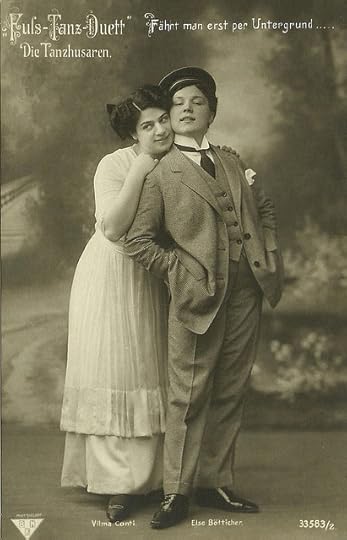
With Vilma Conti. German postcard by BNK, no. 33 583/2. Collection: Didier Hanson.
Caption: "Fuss-Tanz-Duett. Fährt man erst per Untergrund.... Die Tanzhusaren." (Foot-dance duet. You can learn only on the ground.... The Dance Hussars).
Forgotten Silent Productions
According to Wikipedia and other sources, for a long time, the cinema seemed to play only a minor role in the artistic work of Else Bötticher. However, The German Early Cinema Database shows that Bötticher appeared in several now forgotten productions during the 1910s.
Her first film was the Messter production Fräulein Leutnant/Miss Lieutenant (Carl Wilhelm, 1914) in which she played the title role opposite Albert Paulig and Hans Mierendorff .
She also appeared in the sequel Fräulein Feldgrau/Miss Feldgrau (Carl Wilhelm, 1914) again with Albert Paulig.
Her other silent films included Die Nicht aus Amerika/The Niece from America (1917), Frau Hempels Tochter/Mrs. Hempel’s Daughter (Julius Dewald, Edmund Edel, 1919) and De Profundis (Georg Jacoby, 1919) starring Ellen Richter .
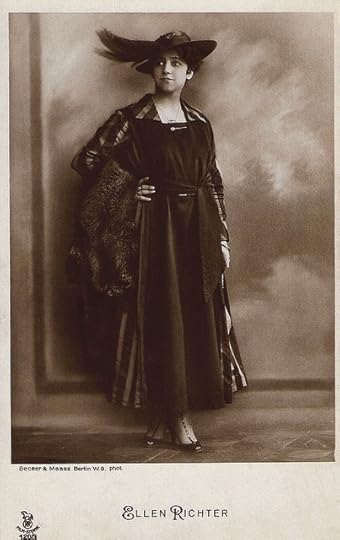
Ellen Richter . German postcard by NBC, no. 120/3. Photo: Becker & Maass, Berlin.
Mothers And Wives
After the seizure of power by the National Socialists, Else Bötticher again regularly performed before the camera. She received mostly small roles – as mothers and wives.
She played the Rectors wife and mother of Annemarie Sörensen in So ein Flegel/Such a Boor (Robert A. Stemmle, 1933) starring Heinz Rühmann in a double role, the earlier version of the hit film Die Feuerzangenbowle/The Punch Bowl (Helmut Weiss, 1943).
In 1933, she also returned to a the Berlin stage and performed at the Metropolitan Theater.
With the outbreak of the war in 1939, she ended her film work for a long time. Her theatrical commitments were also limited.
After the war, the elderly actress only played guest roles.
Her final film appearance was a bit part in Mein Vater, der Schauspieler/My Father the Actor (Robert Siodmak, 1956) starring O.W. Fischer .
In 1966, Else Bötticher died in Berlin. She was 85.
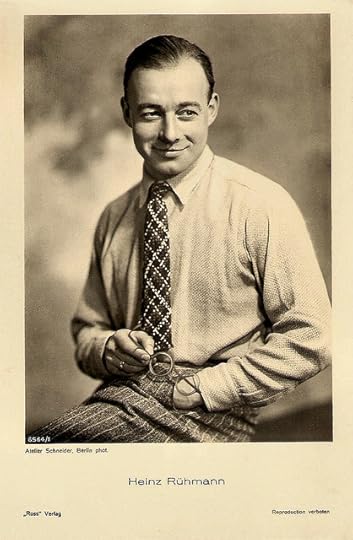
Heinz Rühmann . German postcard by Ross Verlag, no. 6564/1, 1931-1932. Photo: Atelier Schneider, Berlin.
Sources: The German Early Cinema Database, Filmportal.de, Wikipedia (German), and .

With Vilma Conti. German postcard by BNK, no. 33 583/1. Collection: Didier Hanson.
Caption: "Fuss-Tanz-Duett. So ein Damesfüsschen zierlich und klein. Die Tanzhusaren" (Foot-dance duet. Such a dainty and small lady foot. The Dance Hussars).
Acting Greats
Else Bötticher began her career at age 18 in the province. Then she played for two years Nora in theatres in the US.
Back in Germany, she was a partner of such acting greats as Josef Kainz and Max Pallenberg.
Max Reinhardt engaged her several times for his guest directions in Munich. Bötticher also repeatedly did guest performances in the Netherlands, Switzerland, Belgium, and France.
However, she worked mainly in German theatres such as the Königlichen Hoftheater zu Stuttgart (Royal Court Theatre in Stuttgart) and especially, since shortly before the First World War, in Berlin theatres such as the Trianon-Theater.
In the later years of the Weimar Republic, she was seen at the Neues Theater am Zoo and other stages.

With Vilma Conti. German postcard by BNK, no. 33 583/2. Collection: Didier Hanson.
Caption: "Fuss-Tanz-Duett. Fährt man erst per Untergrund.... Die Tanzhusaren." (Foot-dance duet. You can learn only on the ground.... The Dance Hussars).
Forgotten Silent Productions
According to Wikipedia and other sources, for a long time, the cinema seemed to play only a minor role in the artistic work of Else Bötticher. However, The German Early Cinema Database shows that Bötticher appeared in several now forgotten productions during the 1910s.
Her first film was the Messter production Fräulein Leutnant/Miss Lieutenant (Carl Wilhelm, 1914) in which she played the title role opposite Albert Paulig and Hans Mierendorff .
She also appeared in the sequel Fräulein Feldgrau/Miss Feldgrau (Carl Wilhelm, 1914) again with Albert Paulig.
Her other silent films included Die Nicht aus Amerika/The Niece from America (1917), Frau Hempels Tochter/Mrs. Hempel’s Daughter (Julius Dewald, Edmund Edel, 1919) and De Profundis (Georg Jacoby, 1919) starring Ellen Richter .

Ellen Richter . German postcard by NBC, no. 120/3. Photo: Becker & Maass, Berlin.
Mothers And Wives
After the seizure of power by the National Socialists, Else Bötticher again regularly performed before the camera. She received mostly small roles – as mothers and wives.
She played the Rectors wife and mother of Annemarie Sörensen in So ein Flegel/Such a Boor (Robert A. Stemmle, 1933) starring Heinz Rühmann in a double role, the earlier version of the hit film Die Feuerzangenbowle/The Punch Bowl (Helmut Weiss, 1943).
In 1933, she also returned to a the Berlin stage and performed at the Metropolitan Theater.
With the outbreak of the war in 1939, she ended her film work for a long time. Her theatrical commitments were also limited.
After the war, the elderly actress only played guest roles.
Her final film appearance was a bit part in Mein Vater, der Schauspieler/My Father the Actor (Robert Siodmak, 1956) starring O.W. Fischer .
In 1966, Else Bötticher died in Berlin. She was 85.

Heinz Rühmann . German postcard by Ross Verlag, no. 6564/1, 1931-1932. Photo: Atelier Schneider, Berlin.
Sources: The German Early Cinema Database, Filmportal.de, Wikipedia (German), and .
Published on August 27, 2013 23:00
August 26, 2013
Imported from the USA: Josephine Baker
Today, we continue our new series 'Imported from the USA'. Tall and dark Josephine Baker (1906-1975) was an American singer and dancer who became a legend in Europe. In 1925 'the Bronze Venus' became an instant success in Paris with her coffee skin, ebony eyes, long legs, and 'smile to end all smiles'. She was the first African American female to become a world-famous entertainer, to integrate an American concert hall, and to star in a major film, the French production La Sirene des Tropiques/Siren of the Tropics (1927).

Austrian postcard by Iris Verlag, no. 5293. Photo: Walery, Paris
Racial Discrimination
Josephine Baker was born Frida Josephine McDonald in 1906, in St. Louis, Missouri, US. Her mother, Carrie McDonald, was a laundress, and her father, Eddie Carson, a vaudeville drummer.
Josephine dropped out of school at the age of 12, and first danced for the public on the streets of St. Louis for nickels and dimes.
At 15, she was recruited for the St. Louis Chorus vaudeville show, and she married a Pullman porter named William Howard Baker. Two years later she left him and ran away from St. Louis, feeling there was too much racial discrimination in the city.
She headed to New York City and during the Harlem Renaissance, she performed at the Plantation Club and in the chorus of the popular Broadway revues Shuffle Along (1921) and The Chocolate Dandies (1924).
She performed as the last dancer in a chorus line, a position in which the dancer traditionally performed in a comic manner, as if they were unable to remember the dance, until the encore, at which point they would not only perform it correctly, but with additional complexity.
Josephine Baker was then billed as 'the highest-paid chorus girl in vaudeville.'

Albert Prejean . German Postcard by Ross Verlag, no. 6201/1, 1931-1932. Photo: Paramount.
Banana Dance
In 1925, Josephine Baker opened in Paris in La revue negre at the Théatre des Champs-Élysées, where she became an instant success for her erotic dancing and for appearing practically nude on stage.
After a successful tour of Europe, she reneged on her contract and returned to France to star at the Folies Bergères, setting the standard for her future acts.
She performed the Danse sauvage, wearing a costume consisting of a skirt made of a string of artificial bananas. She quickly became a favourite of the French, and her fame grew.
Baker performed in a handful of silent and early sound films, including La Sirene des Tropiques/Siren of the Tropics (Henri Étiévant, Mario Nalpas, 1927) at the side of Pierre Batcheff , Zouzou (Marc Allégret, 1934) opposite Jean Gabin , and La princesse Tam Tam/Princess Tam-Tam (Edmond T. Gréville, 1935) with Albert Préjean .
At this time she also scored her greatest song hit, J'ai deux amours (1931).
In 1937 she renounced her American citizenship and became a citizen of France.
During World War II she served in the French Resistance for which she would receive the highest French military honour, the Croix de Guerre.

Romanian postcard by Casa Filmului Acin, no. 5293, 1970.
Communist Sympathizer?
Josephine Baker had many ups and downs during her career.
Although based in France, Baker supported the American Civil Rights Movement during the 1950s. In 1951 the Stork Club in New York City had refused to serve her because she was black. This led to a confrontation with columnist Walter Winchell.
Later, she was falsely accused of being a communist sympathizer, and the FBI started a file on her. During the McCarthy era, she was told that she was no longer welcome in the United States.
In France, she was made a Chevalier of the Légion d'honneur, France's highest honour, in 1961.
In the late 1960's, she began having financial difficulties, and stopped performing in 1968. Princess Grace offered her a home in Monaco when she learned of Josephine's financial problems.
At the request of Princess Grace, she performed at Monaco's summer ball in 1974, and was a great success. That same year, she staged a week of performances in New York and called the show An Evening with Josephine Baker.
Baker had just begun a Paris revue celebrating her half-century on the stage, when on 10 April 1975 she was stricken and went into a coma. She died without regaining consciousness.
Her funeral was held in Paris, and she was buried in Monaco.
Josephine Baker was married six times: to foundry worker Willie Wells (1919), William Howard Baker (1920-1923), 'Count' Pepito di Abatino (1926), French sugar magnate Jean Lion (1937-1938), orchestra leader Joe Bouillon (1947-1957) and finally to American artist Robert Brady (1973 till her death in 1975).
She adopted 12 children, partly because she couldn't have any of her own and partly because she believed in equality for all, no matter what nationality, religion or race.
Josephine Baker performs the Danse sauvage at the Folies Bergères. Source: dsmrtgrl (YouTube).
Josephine Baker in Pathécolor, shot for the french silent film La Revue Des Revues (1927). Source: stjn00 (YouTube).
The first episode of 'Imported from the USA' was dedicated to Jayne Mansfield .
Sources: Wikipedia and .

Austrian postcard by Iris Verlag, no. 5293. Photo: Walery, Paris
Racial Discrimination
Josephine Baker was born Frida Josephine McDonald in 1906, in St. Louis, Missouri, US. Her mother, Carrie McDonald, was a laundress, and her father, Eddie Carson, a vaudeville drummer.
Josephine dropped out of school at the age of 12, and first danced for the public on the streets of St. Louis for nickels and dimes.
At 15, she was recruited for the St. Louis Chorus vaudeville show, and she married a Pullman porter named William Howard Baker. Two years later she left him and ran away from St. Louis, feeling there was too much racial discrimination in the city.
She headed to New York City and during the Harlem Renaissance, she performed at the Plantation Club and in the chorus of the popular Broadway revues Shuffle Along (1921) and The Chocolate Dandies (1924).
She performed as the last dancer in a chorus line, a position in which the dancer traditionally performed in a comic manner, as if they were unable to remember the dance, until the encore, at which point they would not only perform it correctly, but with additional complexity.
Josephine Baker was then billed as 'the highest-paid chorus girl in vaudeville.'

Albert Prejean . German Postcard by Ross Verlag, no. 6201/1, 1931-1932. Photo: Paramount.
Banana Dance
In 1925, Josephine Baker opened in Paris in La revue negre at the Théatre des Champs-Élysées, where she became an instant success for her erotic dancing and for appearing practically nude on stage.
After a successful tour of Europe, she reneged on her contract and returned to France to star at the Folies Bergères, setting the standard for her future acts.
She performed the Danse sauvage, wearing a costume consisting of a skirt made of a string of artificial bananas. She quickly became a favourite of the French, and her fame grew.
Baker performed in a handful of silent and early sound films, including La Sirene des Tropiques/Siren of the Tropics (Henri Étiévant, Mario Nalpas, 1927) at the side of Pierre Batcheff , Zouzou (Marc Allégret, 1934) opposite Jean Gabin , and La princesse Tam Tam/Princess Tam-Tam (Edmond T. Gréville, 1935) with Albert Préjean .
At this time she also scored her greatest song hit, J'ai deux amours (1931).
In 1937 she renounced her American citizenship and became a citizen of France.
During World War II she served in the French Resistance for which she would receive the highest French military honour, the Croix de Guerre.

Romanian postcard by Casa Filmului Acin, no. 5293, 1970.
Communist Sympathizer?
Josephine Baker had many ups and downs during her career.
Although based in France, Baker supported the American Civil Rights Movement during the 1950s. In 1951 the Stork Club in New York City had refused to serve her because she was black. This led to a confrontation with columnist Walter Winchell.
Later, she was falsely accused of being a communist sympathizer, and the FBI started a file on her. During the McCarthy era, she was told that she was no longer welcome in the United States.
In France, she was made a Chevalier of the Légion d'honneur, France's highest honour, in 1961.
In the late 1960's, she began having financial difficulties, and stopped performing in 1968. Princess Grace offered her a home in Monaco when she learned of Josephine's financial problems.
At the request of Princess Grace, she performed at Monaco's summer ball in 1974, and was a great success. That same year, she staged a week of performances in New York and called the show An Evening with Josephine Baker.
Baker had just begun a Paris revue celebrating her half-century on the stage, when on 10 April 1975 she was stricken and went into a coma. She died without regaining consciousness.
Her funeral was held in Paris, and she was buried in Monaco.
Josephine Baker was married six times: to foundry worker Willie Wells (1919), William Howard Baker (1920-1923), 'Count' Pepito di Abatino (1926), French sugar magnate Jean Lion (1937-1938), orchestra leader Joe Bouillon (1947-1957) and finally to American artist Robert Brady (1973 till her death in 1975).
She adopted 12 children, partly because she couldn't have any of her own and partly because she believed in equality for all, no matter what nationality, religion or race.
Josephine Baker performs the Danse sauvage at the Folies Bergères. Source: dsmrtgrl (YouTube).
Josephine Baker in Pathécolor, shot for the french silent film La Revue Des Revues (1927). Source: stjn00 (YouTube).
The first episode of 'Imported from the USA' was dedicated to Jayne Mansfield .
Sources: Wikipedia and .
Published on August 26, 2013 23:00
August 25, 2013
Dorrit Weixler
German silent film actress Dorrit Weixler (1892-1916) anticipated such better known comedy stars of the German cinema as Ossi Oswalda and Anny Ondra. The career of the bright and light comedienne was like a candle burning on both sides.
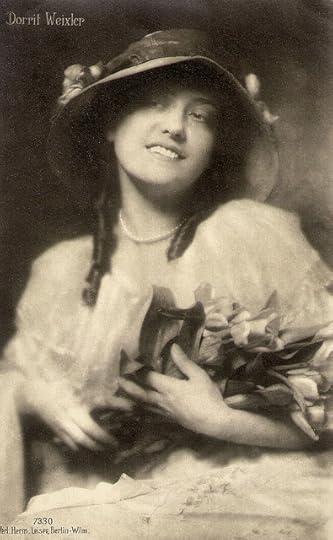
German Postcard by Verlag Hermann Leiser, Berlin-Wilm, no. 7330.
Quicksilver
Dorrit Weixler was born in 1892. She first appeared in short films in 1911, like Seine erste Liebe/His First Love (Alwin Neuss, 1911) and Alwin auf der Hochzeitsreise/Alwin's Honeymoon Trip (Alwin Neuss, 1911), both featuring Alwin Neuss.
In 1913 she began a successful collaboration with silent film director-screenwriter Franz Hofer at the Luna Film studio. She had her breakthrough with Das rosa Pantöffelchen/The Pink Slipper (Franz Hofer, 1913) with Franz Schwaiger. Hofer and Weixler would make ten films together such as Das Liebesbarometer/The Barometer of Love (Franz Hofer, 1914). In Ein verliebter Racker/A Rascal in Love (Franz Hofer, 1915) and Fraülein Piccolo/Miss piccolo (Franz Hofer, 1915) her film partner was the future film director Ernst Lubitsch. In Fraülein Piccolo she played a quicksilver waitress dressed up as a boy to push away the clients.
Other popular roles were the temperamental teenager or the tomboy in sailor suit who is tamed by the 'right man'. During the First World War, Hofer directed her also in such patriotic war dramas as Deutsche Helden/German heroes (Franz Hofer, 1914) and Weihnachtsglöckchen/Christmas Bells (Franz Hofer, 1914).
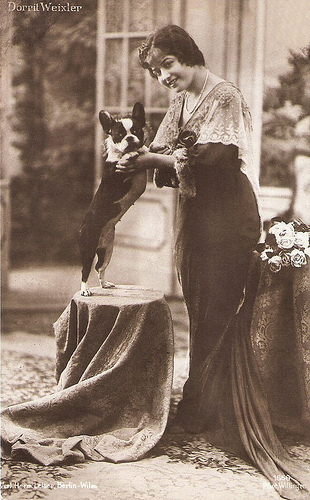
German postcard by Verlag Herm. Leiser, Berlin-Wilm, no. 1550. Photo: Willingen.
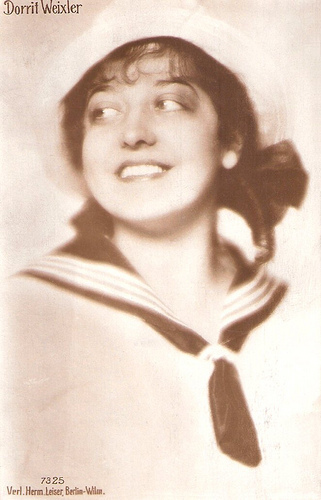
German postcard by Verl. Hermann Leiser, Berlin, no. 7325.
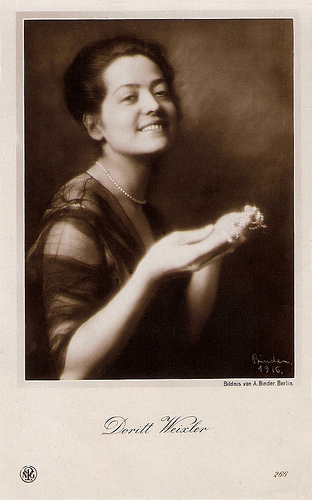
German postcard by NPG, no. 266. Photo: Alex Binder, 1916.
Stress
In 1915, Dorrit Weixler left Hofer and Luna Film to work for producer David Oliver at Oliver-Film, where she became the leading actress. Her type of roles stayed the same, and her directors Paul Otto and Paul Heidemann were often also her partners on screen.
The films were all about her and sometimes bore her name in the titles. Examples are Dorrits Chauffeur (Paul Otto, 1915) and Dorritts Vergnügungsreise/Dorritts pleasure trip (Paul Heidemann, 1916) opposite Bruno Kastner.
End of May 1916, she made her stage debut in the Theater am Nollendorfplatz in a 'Dorrit Weixler-week'. One night she collapsed on stage. Unfortunately the stress of turning out one film after another - over 20 films in two years - had been too much for Dorrit. While trying to recover in a Berlin sanatorium, matters grew worse. She became dependent on morphine. In 1916, at the apex of her success, Dorrit Weixler committed suicide by hanging herself. She was only 24 years old.
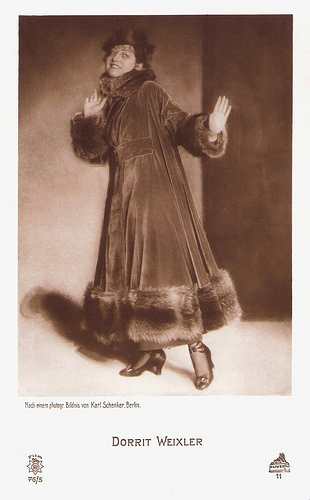
German postcard by Rotophot in the Film Sterne series, no. 76/5. Photo: Karl Schenker, Berlin.
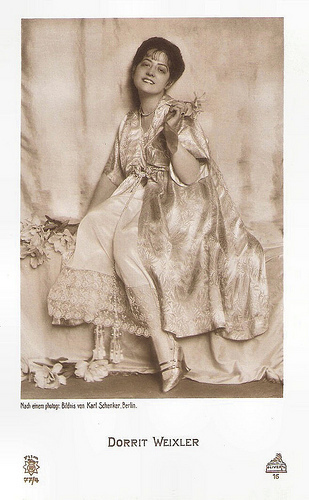
German postcard by Rotophot in the Film Sterne series, no. 77/4. Photo: Karl Schenker, Berlin.
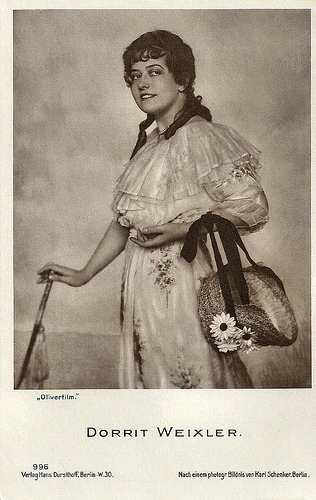
German postcard by Verlag Hans Dursthoff, Berlin, no. 996. Photo: Karl Schenker, Berlin / Oliver-Film.
Sources: André Stratmann (Stummfilmfan) (German), Thomas Staedeli (Cyranos), Wikipedia (German) and .

German Postcard by Verlag Hermann Leiser, Berlin-Wilm, no. 7330.
Quicksilver
Dorrit Weixler was born in 1892. She first appeared in short films in 1911, like Seine erste Liebe/His First Love (Alwin Neuss, 1911) and Alwin auf der Hochzeitsreise/Alwin's Honeymoon Trip (Alwin Neuss, 1911), both featuring Alwin Neuss.
In 1913 she began a successful collaboration with silent film director-screenwriter Franz Hofer at the Luna Film studio. She had her breakthrough with Das rosa Pantöffelchen/The Pink Slipper (Franz Hofer, 1913) with Franz Schwaiger. Hofer and Weixler would make ten films together such as Das Liebesbarometer/The Barometer of Love (Franz Hofer, 1914). In Ein verliebter Racker/A Rascal in Love (Franz Hofer, 1915) and Fraülein Piccolo/Miss piccolo (Franz Hofer, 1915) her film partner was the future film director Ernst Lubitsch. In Fraülein Piccolo she played a quicksilver waitress dressed up as a boy to push away the clients.
Other popular roles were the temperamental teenager or the tomboy in sailor suit who is tamed by the 'right man'. During the First World War, Hofer directed her also in such patriotic war dramas as Deutsche Helden/German heroes (Franz Hofer, 1914) and Weihnachtsglöckchen/Christmas Bells (Franz Hofer, 1914).

German postcard by Verlag Herm. Leiser, Berlin-Wilm, no. 1550. Photo: Willingen.

German postcard by Verl. Hermann Leiser, Berlin, no. 7325.

German postcard by NPG, no. 266. Photo: Alex Binder, 1916.
Stress
In 1915, Dorrit Weixler left Hofer and Luna Film to work for producer David Oliver at Oliver-Film, where she became the leading actress. Her type of roles stayed the same, and her directors Paul Otto and Paul Heidemann were often also her partners on screen.
The films were all about her and sometimes bore her name in the titles. Examples are Dorrits Chauffeur (Paul Otto, 1915) and Dorritts Vergnügungsreise/Dorritts pleasure trip (Paul Heidemann, 1916) opposite Bruno Kastner.
End of May 1916, she made her stage debut in the Theater am Nollendorfplatz in a 'Dorrit Weixler-week'. One night she collapsed on stage. Unfortunately the stress of turning out one film after another - over 20 films in two years - had been too much for Dorrit. While trying to recover in a Berlin sanatorium, matters grew worse. She became dependent on morphine. In 1916, at the apex of her success, Dorrit Weixler committed suicide by hanging herself. She was only 24 years old.

German postcard by Rotophot in the Film Sterne series, no. 76/5. Photo: Karl Schenker, Berlin.

German postcard by Rotophot in the Film Sterne series, no. 77/4. Photo: Karl Schenker, Berlin.

German postcard by Verlag Hans Dursthoff, Berlin, no. 996. Photo: Karl Schenker, Berlin / Oliver-Film.
Sources: André Stratmann (Stummfilmfan) (German), Thomas Staedeli (Cyranos), Wikipedia (German) and .
Published on August 25, 2013 23:00
August 24, 2013
Lea Giunchi
Lea Giunchi (1884-?) was the first comical actress in Italian cinema. She acted either in her own 'Lea' series, or with male comedians such as Ferdinand Guillaume (Tontolini) and Raymond Frau (Kri Kri). She also played in the Italian silent epic Quo vadis? (1913), modern dramas and action films.

British postcard by Rotary in the Opalette Series, O.3077.A. Photo: E.C. Publicity still of Lea Giunchi as Lygia in Quo vadis? (Enrico Guazzoni, 1913).
Lea, Tontolini and Kri Kri
Despite Wikipedia indicating differently, Lea Giunchi was born Armanda Carolina Giunchi in Dusseldorf, Germany in 1889. She was the daughter of an Italian father and a German mother. In 1909 she moved to Rome. There her professional career took off when she became the companion of Natale Guillaume. Together with his elder – and more famous - brother Ferdinando Guillaume, Guillaume was the fourth generation of a French family who had fled from France in the late 18th century and led the life of wandering circus artists. Natale left the family circus after his father Onorato remarried. His brother Ferdinando joined him, and together they did circus acts in various European circuses. Around 1907 they started to perform in vaudeville at the Sala Umberto in Rome, under the name of 'Les Guill-Guill'. Wikipedia suggests that Giunchi was already a part of these performances.
In 1909 the Guillaume brothers were hired by the Cines film company in Rome, to become comical actors and compete with the popular French comedian André Deed. In 1910, a whole series was designed around the character of Tontolini, played by Ferdinando, and with Natale as his sidekick or antagonist. It is then that Lea Giunchi as well started to act in the films with the Guillaume brothers, firstly in Tontolini e Lea al mare/Tontolini and Lea at the Seaside (1910). Immediately she became the companion of the character Tontolini, using the name Lea (not Armanda and without her last name). Giunchi remained Ferdinando Guillaume’s sidekick in countless comedies, until Guillaume moved over the Turinese company Pasquali and became Polidor. Giunchi had become so popular that she got her own Lea series, as of 1910, starting with Lea in convitto/Lea in Her Boarding School.
Until 1916 Giunchi surely acted in some 34 Lea comedies, which were distributed all over Europe and to the United States. Examples are Lea si diverte/Lea has fun (1912), Lea vuol morire/Lea wants to die1912), and Lea e il gomitolo/Lea and the ball (1913). Giunchi collaborated with several male comedians: the fat Giuseppe Gambardella, known as Checco, Lorenzo Soderini aka Cocò, also often in drag as the ugly female antagonist of Lea, and foremost Raymond Frau, who replaced Guillaume as first comedian at Cines, when the latter left for Pasquali. Known as Kri Kri, Frau coupled with Giunchi in many comedies in the early 1910s, such as Kri Kri ama la tintora/Kri Kri loves tintora (1913) and Kri Kri e Lea militari/Kri Kri and Lea military (1913).
Giunchi continued to play in the Kri Kri films until 1915. She also joined forces in comical shorts with her own little son Eraldo, born in Rome in 1910 (and not 1906 as Wikipedia and IMDb write), and known as Cinessino. In 1911 Giunchi and Guillaume had a daughter, Sylvia. In the meantime Giunchi played in dramatic films, e.g. as Marta in Enrico Guazzoni’s adaptation of Faust (1910), and (despite her pregnancy of Eraldo) she was the Blue Fairy in Pinocchio (Giulio Antamoro, 1911), an early feature-length film with the whole Guillaume family acting.
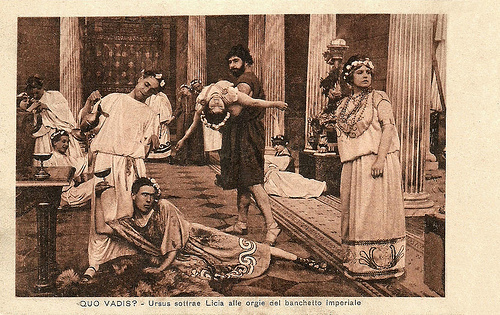
Italian postcard by Uff. Rev. St. Terni. Photo: Cines Film. Publicity still for Quo Vadis? (Enrico Guazzoni, 1913). Helped by Acte, Nero's former mistress, Ursus (Bruto Castellani) subtracts Lygia (Lea Giunchi) from the orgy of the imperial banquet, where the drunken Roman Vinicius tries to rape her.
A Worldwide Sensation
Lea Giunchi had her breakthrough as dramatic actress with the part of the Christian girl Lygia (Licia in Italian) in the epic Quo vadis? (Enrico Guazzoni, 1912). The film was a worldwide sensation. She played also dramatic roles in Fior d’amore e fior di morte/Flower of love and death (1912) and Immolazione/Immolation (Enrico Guazzoni, 1914). Because of her special physical talents, Lea Giunchi played in several types of action films, from Westerns like Due vite per un cuore/A Sister's Ordeal (1912) and Sulla via dell’oro/On the golden way (1913) to mystery and detective films, such as Le mani ignote/The unknown hands (1913) and La polizia moderna )1912).
In her thesis on Giunchi, Marzia Ruta writes: “Giunchi’s acting peculiarity consisted in her ability to combine two different aspects in one single characterization: she made use of her body in a very free way, yet at the same time she also managed to be extremely charming and feminine. This is a case on its own in the context of Italian cinema of the time, where no other comic actress presented both these aspects at once: either they were the big fat woman who hit and tyrannized her poor little comic partner, or, in reverse, the coquettish and funny girl with a great ability in facial expressions (the best example of this type being the great Gigetta Morano). On the contrary, Lea made use of both the free and unprejudiced movements of her body and a coquettish femininity: this was quite a revolutionary combination of elements for the time, and Giunchi was the first, and probably the only actress to introduce it in Italian cinema. (...)
In Lea e il gomitolo (1913) Giunchi destroys her parents’ whole apartment by desperately searching for a lost ball of wool: her frenzy movement, quite like a demoniac possession, is a metaphor for Lea’s desperate search for the only female identity she knows and can imagine; by destroying the apartment, she conquers both her right to read in peace and the possibility of an alternative female identity. At a time when Italian women were not allowed to vote because their husbands were held to also represent their will, Lea persuades her boyfriend’s parents to let their son marry her by disguising herself as a doll: a big puppet who complies with all of its owner’s instructions (Lea bambola/Lea doll, 1912).”
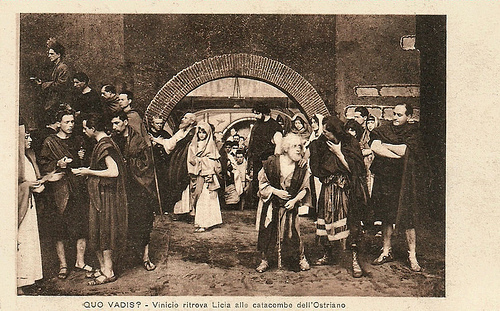
Italian postcard by Uff. Rev. St. Terni. Photo: Cines Film. Publicity still for Quo Vadis? (Enrico Guazzoni, 1913). Vinicius (Amleto Novelli) finds back Lygia (Lea Giunchi) at the catacombs of Ostriano. Left of Lygia is St. Peter (Giovanni Gizzi), right of her protector Ursus (Bruto Castellani). Vinicius plots to abduct Lygia, with the help of the Greek Chilo (Augusto Mastripietri) and a gladiator.
A Fatal Blow
While Natale Guillaume acted in several Polidor-comedies in Turin in 1914-1916, Lea Giunchi seems to have stayed in Rome, continuing at Cines. In 1915 Giunchi also signed a contract with the Caesar Film and acted for this company in such films as La cieca di Sorrento/Blind Woman of Sorrento (Gustavo Serena, 1916) in which she had the lead as the blind girl, Parigi misteriosa/Mysterious Paris (1917), an adaptation of Eugene Sue, and P.L.M., ossia l’assassinio della Paris-Lyon-Mediterranée/P.L.M. ie the murder of the Paris-Lyon-Méditerranée (Edoardo Bencivenga, 1918).
In the mid-1910s she also acted at companies like Celio in La maschera dell’amore (Ivo Illuminati, 1916), and Film d’Arte Italiana in La chiamavano Cosetta (Eugenio Perego, 1917). The big wave of Italian short comedy petered out during the mid-1910s, which meant less work for Giunchi. A fatal blow came after the First World War, when her companion – they apparently never married – Natale Guillaume was killed in an aerial accident, during the shooting in Naples of a film for Polidor Film, the company founded by his brother Ferdinando.
A few months after, Lea Giunchi married Anselmo Muto, a doctor from Gaeta fifteen years older than she. Giunchi withdrew from public life for good. Muto died in Rome in 1940. After the Second World War, in 1946, Lea and Sylvia left Rome and moved to Gaeta, probably to join Muto's family. In 1951 Lea emigrated with Sylvia and Eraldo and their families to Rio De Janeiro, after which traces of her get lost. While Giunchi remains a rather enigmatic personality, several of her long and short films remain in archives inside and outside of Italy. Her brother-in-law Ferdinando was rediscovered by Federico Fellini in the post-war era and would act in Le notti di Cabiria/Nights of Cabiria (Federico Fellini, 1957) and La dolce vita (Federico Fellini, 1960). He died at the high age of 90.
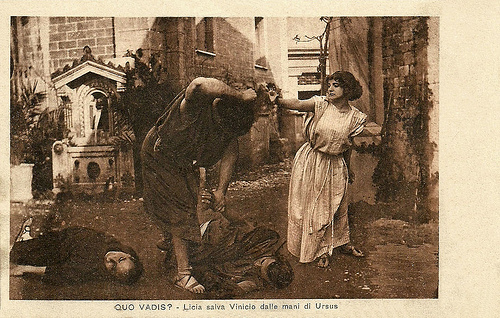
Italian postcard by Uff. Rev. St. Terni. Photo: Cines Film. Publicity still for Quo Vadis? (Enrico Guazzoni, 1913). Lygia (Lea Giunchi) saves Vinicius (Amleto Novelli) from the hands of Ursus (Bruto Castellani). Ursus, protector of Lygia, has just killed a gladiator who had been charged by Vinicius to kill Ursus while he himself planned to abduct Lygia.
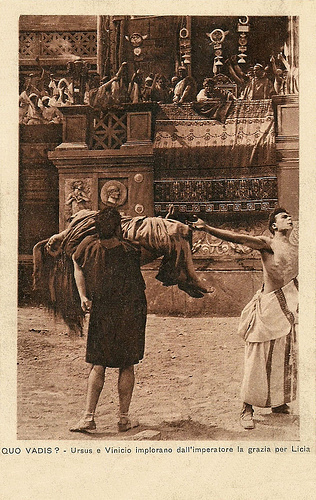
Italian postcard by Uff. Rev. St. Terni. Photo: Cines Film. Publicity still for Quo Vadis? (Enrico Guazzoni, 1913). Ursus (Bruto Castellani) and Vinicius (Amleto Novelli) implore the audience and emperor Nero to grace the Christian Lygia (Lea Giunchi), after Ursus has killed the bull on whch back Lygia had been bound. The audience raves because of Ursus' tour de force. Vinicius has stripped his cloth to show his scars from the wars, while Ursus holds up Lygia. All around Nero hold their thumbs up for grace, even if this sign seems to have been a 19th century invention and historically incorrect.
Sources: Marzia Ruta,(Riavvolgendo il gomitolo: Lea Giunchi, storia di un corpo comico dimenticato (thesis, Bologna, 2008)), Marzia Ruta (Women and the Silent Screen conference 2010), Wikipedia (Italian) and
Thanks to Marzia Ruta for additional information and corrections.

British postcard by Rotary in the Opalette Series, O.3077.A. Photo: E.C. Publicity still of Lea Giunchi as Lygia in Quo vadis? (Enrico Guazzoni, 1913).
Lea, Tontolini and Kri Kri
Despite Wikipedia indicating differently, Lea Giunchi was born Armanda Carolina Giunchi in Dusseldorf, Germany in 1889. She was the daughter of an Italian father and a German mother. In 1909 she moved to Rome. There her professional career took off when she became the companion of Natale Guillaume. Together with his elder – and more famous - brother Ferdinando Guillaume, Guillaume was the fourth generation of a French family who had fled from France in the late 18th century and led the life of wandering circus artists. Natale left the family circus after his father Onorato remarried. His brother Ferdinando joined him, and together they did circus acts in various European circuses. Around 1907 they started to perform in vaudeville at the Sala Umberto in Rome, under the name of 'Les Guill-Guill'. Wikipedia suggests that Giunchi was already a part of these performances.
In 1909 the Guillaume brothers were hired by the Cines film company in Rome, to become comical actors and compete with the popular French comedian André Deed. In 1910, a whole series was designed around the character of Tontolini, played by Ferdinando, and with Natale as his sidekick or antagonist. It is then that Lea Giunchi as well started to act in the films with the Guillaume brothers, firstly in Tontolini e Lea al mare/Tontolini and Lea at the Seaside (1910). Immediately she became the companion of the character Tontolini, using the name Lea (not Armanda and without her last name). Giunchi remained Ferdinando Guillaume’s sidekick in countless comedies, until Guillaume moved over the Turinese company Pasquali and became Polidor. Giunchi had become so popular that she got her own Lea series, as of 1910, starting with Lea in convitto/Lea in Her Boarding School.
Until 1916 Giunchi surely acted in some 34 Lea comedies, which were distributed all over Europe and to the United States. Examples are Lea si diverte/Lea has fun (1912), Lea vuol morire/Lea wants to die1912), and Lea e il gomitolo/Lea and the ball (1913). Giunchi collaborated with several male comedians: the fat Giuseppe Gambardella, known as Checco, Lorenzo Soderini aka Cocò, also often in drag as the ugly female antagonist of Lea, and foremost Raymond Frau, who replaced Guillaume as first comedian at Cines, when the latter left for Pasquali. Known as Kri Kri, Frau coupled with Giunchi in many comedies in the early 1910s, such as Kri Kri ama la tintora/Kri Kri loves tintora (1913) and Kri Kri e Lea militari/Kri Kri and Lea military (1913).
Giunchi continued to play in the Kri Kri films until 1915. She also joined forces in comical shorts with her own little son Eraldo, born in Rome in 1910 (and not 1906 as Wikipedia and IMDb write), and known as Cinessino. In 1911 Giunchi and Guillaume had a daughter, Sylvia. In the meantime Giunchi played in dramatic films, e.g. as Marta in Enrico Guazzoni’s adaptation of Faust (1910), and (despite her pregnancy of Eraldo) she was the Blue Fairy in Pinocchio (Giulio Antamoro, 1911), an early feature-length film with the whole Guillaume family acting.

Italian postcard by Uff. Rev. St. Terni. Photo: Cines Film. Publicity still for Quo Vadis? (Enrico Guazzoni, 1913). Helped by Acte, Nero's former mistress, Ursus (Bruto Castellani) subtracts Lygia (Lea Giunchi) from the orgy of the imperial banquet, where the drunken Roman Vinicius tries to rape her.
A Worldwide Sensation
Lea Giunchi had her breakthrough as dramatic actress with the part of the Christian girl Lygia (Licia in Italian) in the epic Quo vadis? (Enrico Guazzoni, 1912). The film was a worldwide sensation. She played also dramatic roles in Fior d’amore e fior di morte/Flower of love and death (1912) and Immolazione/Immolation (Enrico Guazzoni, 1914). Because of her special physical talents, Lea Giunchi played in several types of action films, from Westerns like Due vite per un cuore/A Sister's Ordeal (1912) and Sulla via dell’oro/On the golden way (1913) to mystery and detective films, such as Le mani ignote/The unknown hands (1913) and La polizia moderna )1912).
In her thesis on Giunchi, Marzia Ruta writes: “Giunchi’s acting peculiarity consisted in her ability to combine two different aspects in one single characterization: she made use of her body in a very free way, yet at the same time she also managed to be extremely charming and feminine. This is a case on its own in the context of Italian cinema of the time, where no other comic actress presented both these aspects at once: either they were the big fat woman who hit and tyrannized her poor little comic partner, or, in reverse, the coquettish and funny girl with a great ability in facial expressions (the best example of this type being the great Gigetta Morano). On the contrary, Lea made use of both the free and unprejudiced movements of her body and a coquettish femininity: this was quite a revolutionary combination of elements for the time, and Giunchi was the first, and probably the only actress to introduce it in Italian cinema. (...)
In Lea e il gomitolo (1913) Giunchi destroys her parents’ whole apartment by desperately searching for a lost ball of wool: her frenzy movement, quite like a demoniac possession, is a metaphor for Lea’s desperate search for the only female identity she knows and can imagine; by destroying the apartment, she conquers both her right to read in peace and the possibility of an alternative female identity. At a time when Italian women were not allowed to vote because their husbands were held to also represent their will, Lea persuades her boyfriend’s parents to let their son marry her by disguising herself as a doll: a big puppet who complies with all of its owner’s instructions (Lea bambola/Lea doll, 1912).”

Italian postcard by Uff. Rev. St. Terni. Photo: Cines Film. Publicity still for Quo Vadis? (Enrico Guazzoni, 1913). Vinicius (Amleto Novelli) finds back Lygia (Lea Giunchi) at the catacombs of Ostriano. Left of Lygia is St. Peter (Giovanni Gizzi), right of her protector Ursus (Bruto Castellani). Vinicius plots to abduct Lygia, with the help of the Greek Chilo (Augusto Mastripietri) and a gladiator.
A Fatal Blow
While Natale Guillaume acted in several Polidor-comedies in Turin in 1914-1916, Lea Giunchi seems to have stayed in Rome, continuing at Cines. In 1915 Giunchi also signed a contract with the Caesar Film and acted for this company in such films as La cieca di Sorrento/Blind Woman of Sorrento (Gustavo Serena, 1916) in which she had the lead as the blind girl, Parigi misteriosa/Mysterious Paris (1917), an adaptation of Eugene Sue, and P.L.M., ossia l’assassinio della Paris-Lyon-Mediterranée/P.L.M. ie the murder of the Paris-Lyon-Méditerranée (Edoardo Bencivenga, 1918).
In the mid-1910s she also acted at companies like Celio in La maschera dell’amore (Ivo Illuminati, 1916), and Film d’Arte Italiana in La chiamavano Cosetta (Eugenio Perego, 1917). The big wave of Italian short comedy petered out during the mid-1910s, which meant less work for Giunchi. A fatal blow came after the First World War, when her companion – they apparently never married – Natale Guillaume was killed in an aerial accident, during the shooting in Naples of a film for Polidor Film, the company founded by his brother Ferdinando.
A few months after, Lea Giunchi married Anselmo Muto, a doctor from Gaeta fifteen years older than she. Giunchi withdrew from public life for good. Muto died in Rome in 1940. After the Second World War, in 1946, Lea and Sylvia left Rome and moved to Gaeta, probably to join Muto's family. In 1951 Lea emigrated with Sylvia and Eraldo and their families to Rio De Janeiro, after which traces of her get lost. While Giunchi remains a rather enigmatic personality, several of her long and short films remain in archives inside and outside of Italy. Her brother-in-law Ferdinando was rediscovered by Federico Fellini in the post-war era and would act in Le notti di Cabiria/Nights of Cabiria (Federico Fellini, 1957) and La dolce vita (Federico Fellini, 1960). He died at the high age of 90.

Italian postcard by Uff. Rev. St. Terni. Photo: Cines Film. Publicity still for Quo Vadis? (Enrico Guazzoni, 1913). Lygia (Lea Giunchi) saves Vinicius (Amleto Novelli) from the hands of Ursus (Bruto Castellani). Ursus, protector of Lygia, has just killed a gladiator who had been charged by Vinicius to kill Ursus while he himself planned to abduct Lygia.

Italian postcard by Uff. Rev. St. Terni. Photo: Cines Film. Publicity still for Quo Vadis? (Enrico Guazzoni, 1913). Ursus (Bruto Castellani) and Vinicius (Amleto Novelli) implore the audience and emperor Nero to grace the Christian Lygia (Lea Giunchi), after Ursus has killed the bull on whch back Lygia had been bound. The audience raves because of Ursus' tour de force. Vinicius has stripped his cloth to show his scars from the wars, while Ursus holds up Lygia. All around Nero hold their thumbs up for grace, even if this sign seems to have been a 19th century invention and historically incorrect.
Sources: Marzia Ruta,(Riavvolgendo il gomitolo: Lea Giunchi, storia di un corpo comico dimenticato (thesis, Bologna, 2008)), Marzia Ruta (Women and the Silent Screen conference 2010), Wikipedia (Italian) and
Thanks to Marzia Ruta for additional information and corrections.
Published on August 24, 2013 23:00
August 23, 2013
Helmuth Schneider
Blond, handsome actor Helmuth Schneider (1920-1972) appeared in more than 50 films and also worked as an assistant director. He worked in Germany, but also in Latin America, Italy and France.

German postcard by WS-Druck, Wanne-Eickel. Photo: Wega / NF / Michaelis.
Star of the Heimat Film
Helmuth (often Helmut) Schneider was born in Munich, Germany in 1920. Her studied medicine in his hometown in 1938, and then attended the drama school of the Deutsches Theater in Berlin. In 1942 he made his stage debut in the comedy Sophienlund. He had to quit his engagement at the Deutsches Theater for the war effort, and he was wounded in France.
Schneider made his film debut for the Ufa with a small part in the musical drama Träumerei/Daydream (Harald Braun, 1944) about the love story of Clara Wieck Schumann (Hilde Krahl) and Robert Schumann (Mathias Wieman). In 1946, Schneider left Germany and stayed in Latin America where he worked in the film business under the name Alexandre Carlos. In 1952, he was back in Germany and and played at the Deutsches Theater in Göttingen.
In the cinema, he co-starred with Edith Mill in the romantic drama Zwei Menschen/Two People (Paul May, 1952). It made both stars of the Heimat film. The following years he was the handsome hunter or forrester in several forgettable German rural romances, such as Der Fischer vom Heiligensee/The fisherman from Heiligensee (Hans H. König, 1955), Drei Birken auf der Heide/Three birch trees on the heath (Ulrich Erfurth, 1956) and Jägerblut/Blood of the hunter (Hans H. König, 1957). In 1959, he starred as Kara Ben Nemsi in the Karl May adventure Der Löwe von Babylon/The Lion of Babylon (Johannes Kai, Ramón Torrado, 1959) with Georg Thomalla and Theo Lingen.
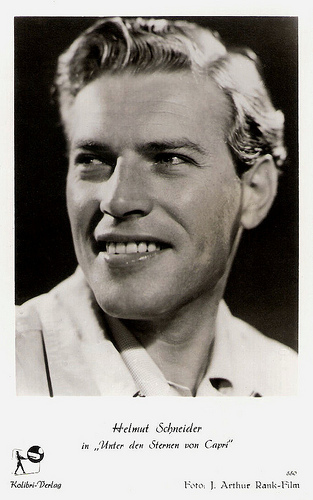
German postcard by Kolibri-Verlag, no. 880. Photo: J. Arthur Rank-Film. Publicity still for Unter den Sternen von Capri/Under the stars of Capri (Otto Linnekogel, 1953).
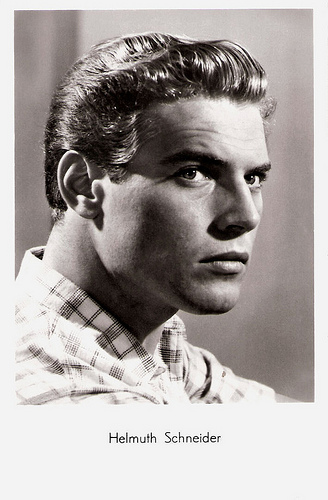
German postcard by F.J. Rüdel, Filmpostkartenverlag, Hamburg-Bergedorf, no. 704.
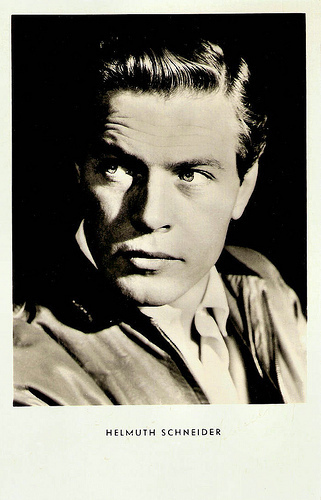
German postcard by Kunst und Bild.
Unsympathetic Nazi Officer
In the 1960s, when the German film industry experienced a downturn, Helmuth Schneider worked for television, such as for the crime series Stahlnetz (1960-1963), the German version of Dragnet. He moved to Rome, which was the new centre of the European cinema. He had a supporting part in the adventure film Captain Sindbad (Byron Haskin, 1963) starring Guy Williams and Heidi Brühl, and the war film The Secret Invasion (Roger Corman, 1964) with Stewart Granger and Raf Vallone.
In France he appeared as an unsympathetic Nazi officer in war dramas like Le facteur s'en va-t-en guerre/The Postman Goes to War (Claude Bernard-Aubert, 1966) starring Charles Aznavour, and Paris brûle-t-il?/Is Paris Burning? (René Clément, 1966) starring Jean-Paul Belmondo and Charles Boyer. He played such a role again in the war comedy La grande vadrouille/Don't Look Now, We've Been Shot At (Gérard Oury, 1966) with Bourvil and Louis de Funès. He also had a part in the fifth and final episode of the Angélique series with Michèle Mercier, Angélique et le sultan/Angélique and the Sultan (Bernard Borderie, 1967).
In Italy he made a Spaghetti Western, Ciakmull - L'uomo della vendetta/The Unholy Four (Enzo Barboni, 1970). Hal Erickson at AllMovie : “It's one of those Spaghetti Westerns in which the heroes and heavies are virtually indistinguishable. Though the outlaw leader (played by George Eastman credited by his birth name Luigi Montefiore) is evil incarnate, he isn't much worse than the four mercenaries hunting him down. Stalwart John Ford-regular Woody Strode is given plenty of screen time, and he makes the most of it. Director Enzo Barboni was billed as E. B. Clucher in the American prints.” Schneider also played in another war film Gott mit uns/The Fifth Day of Peace (Giuliano Montaldo, 1970) starring Franco Nero. His final film was À la guerre comme à la guerre/War is war (Bernard Borderie, 1972), a historical war comedy starring Leonard Whiting and Curd Jürgens.
Helmuth Schneider died in a traffic accident in Rio de Janeiro, Brazil in 1972. He was 51.
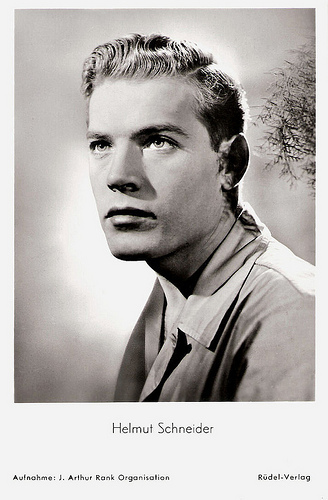
German postcard by F.J. Rüdel, Filmpostkartenverlag, Hamburg-Bergedorf, no. 543. Photo: J. Arthur Rank Organisation. Publicity still for Die Göttin vom Rio Beni/Strange World (Franz Eichhorn, 1951).
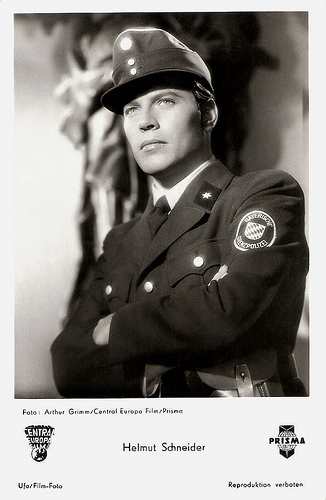
German postcard by Ufa, Berlin-Tempelhof, no. FK 1268. Photo: Arthur Grimm / Central Europa Film / Prisma. Publicity still for Die Schützenliesel/Schützenliesel (Rudolf Schündler, 1954).
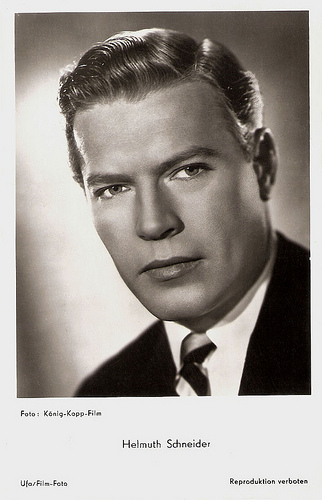
German postcard by Ufa, Berlin-Tempelhof, no. FK 3546. Retail price: 25 Pfg. Photo: König / Kopp-Film.
Sources: Hal Erickson (AllMovie), Peter Hoffmann (Biografie.de) (German), Tom B. (Westerns…all Italiana), Wikipedia (German) and .

German postcard by WS-Druck, Wanne-Eickel. Photo: Wega / NF / Michaelis.
Star of the Heimat Film
Helmuth (often Helmut) Schneider was born in Munich, Germany in 1920. Her studied medicine in his hometown in 1938, and then attended the drama school of the Deutsches Theater in Berlin. In 1942 he made his stage debut in the comedy Sophienlund. He had to quit his engagement at the Deutsches Theater for the war effort, and he was wounded in France.
Schneider made his film debut for the Ufa with a small part in the musical drama Träumerei/Daydream (Harald Braun, 1944) about the love story of Clara Wieck Schumann (Hilde Krahl) and Robert Schumann (Mathias Wieman). In 1946, Schneider left Germany and stayed in Latin America where he worked in the film business under the name Alexandre Carlos. In 1952, he was back in Germany and and played at the Deutsches Theater in Göttingen.
In the cinema, he co-starred with Edith Mill in the romantic drama Zwei Menschen/Two People (Paul May, 1952). It made both stars of the Heimat film. The following years he was the handsome hunter or forrester in several forgettable German rural romances, such as Der Fischer vom Heiligensee/The fisherman from Heiligensee (Hans H. König, 1955), Drei Birken auf der Heide/Three birch trees on the heath (Ulrich Erfurth, 1956) and Jägerblut/Blood of the hunter (Hans H. König, 1957). In 1959, he starred as Kara Ben Nemsi in the Karl May adventure Der Löwe von Babylon/The Lion of Babylon (Johannes Kai, Ramón Torrado, 1959) with Georg Thomalla and Theo Lingen.

German postcard by Kolibri-Verlag, no. 880. Photo: J. Arthur Rank-Film. Publicity still for Unter den Sternen von Capri/Under the stars of Capri (Otto Linnekogel, 1953).

German postcard by F.J. Rüdel, Filmpostkartenverlag, Hamburg-Bergedorf, no. 704.

German postcard by Kunst und Bild.
Unsympathetic Nazi Officer
In the 1960s, when the German film industry experienced a downturn, Helmuth Schneider worked for television, such as for the crime series Stahlnetz (1960-1963), the German version of Dragnet. He moved to Rome, which was the new centre of the European cinema. He had a supporting part in the adventure film Captain Sindbad (Byron Haskin, 1963) starring Guy Williams and Heidi Brühl, and the war film The Secret Invasion (Roger Corman, 1964) with Stewart Granger and Raf Vallone.
In France he appeared as an unsympathetic Nazi officer in war dramas like Le facteur s'en va-t-en guerre/The Postman Goes to War (Claude Bernard-Aubert, 1966) starring Charles Aznavour, and Paris brûle-t-il?/Is Paris Burning? (René Clément, 1966) starring Jean-Paul Belmondo and Charles Boyer. He played such a role again in the war comedy La grande vadrouille/Don't Look Now, We've Been Shot At (Gérard Oury, 1966) with Bourvil and Louis de Funès. He also had a part in the fifth and final episode of the Angélique series with Michèle Mercier, Angélique et le sultan/Angélique and the Sultan (Bernard Borderie, 1967).
In Italy he made a Spaghetti Western, Ciakmull - L'uomo della vendetta/The Unholy Four (Enzo Barboni, 1970). Hal Erickson at AllMovie : “It's one of those Spaghetti Westerns in which the heroes and heavies are virtually indistinguishable. Though the outlaw leader (played by George Eastman credited by his birth name Luigi Montefiore) is evil incarnate, he isn't much worse than the four mercenaries hunting him down. Stalwart John Ford-regular Woody Strode is given plenty of screen time, and he makes the most of it. Director Enzo Barboni was billed as E. B. Clucher in the American prints.” Schneider also played in another war film Gott mit uns/The Fifth Day of Peace (Giuliano Montaldo, 1970) starring Franco Nero. His final film was À la guerre comme à la guerre/War is war (Bernard Borderie, 1972), a historical war comedy starring Leonard Whiting and Curd Jürgens.
Helmuth Schneider died in a traffic accident in Rio de Janeiro, Brazil in 1972. He was 51.

German postcard by F.J. Rüdel, Filmpostkartenverlag, Hamburg-Bergedorf, no. 543. Photo: J. Arthur Rank Organisation. Publicity still for Die Göttin vom Rio Beni/Strange World (Franz Eichhorn, 1951).

German postcard by Ufa, Berlin-Tempelhof, no. FK 1268. Photo: Arthur Grimm / Central Europa Film / Prisma. Publicity still for Die Schützenliesel/Schützenliesel (Rudolf Schündler, 1954).

German postcard by Ufa, Berlin-Tempelhof, no. FK 3546. Retail price: 25 Pfg. Photo: König / Kopp-Film.
Sources: Hal Erickson (AllMovie), Peter Hoffmann (Biografie.de) (German), Tom B. (Westerns…all Italiana), Wikipedia (German) and .
Published on August 23, 2013 23:00
August 22, 2013
Andrée Standard
Andrée Standard (or Standart) appeared in silent French films of the late 1920s as well as in the first French sound production.

French postcard by EC, no. 52. Collection: Didier Hanson.
The Queen
This card of beautiful Andrée Standard is one of the 'rares' of Didier Hanson's collection. It's the only card of her on the net and the actress seems to be completely forgotten. We could not find more information about her than her filmography. But some of her films are very interesting. She appeared both in the greatest epic of the French silent cinema and in the first French sound film.
Andrée Standart started her film career probably in Le prince charmant/Prince Charming (Victor Tourjansky, 1925) with Claude France, Nathalie Kovanko and Jaque Catelain as the Prince. That year she had a bigger role in the comedy 600000 francs par mois/600,000 francs per month (Nicolas Koline, Robert Péguy, 1925) opposite Nicolas Koline and Charles Vanel.
Standart played a queen in the comedy Titi premier, roi des gosses/Titi the first, king of the kids (René Leprince, 1926). In the historical epic Napoléon (Abel Gance, 1927), she played the minor part of Thérèse Tallien. Tallien admires beautiful Joséphine de Beauharnais (Gina Manès) at the Victim's Ball at Les Carmes, formerly the prison where Joséphine was held. She was credited now as Andrée Standard, and continued to be so in some of her following films.
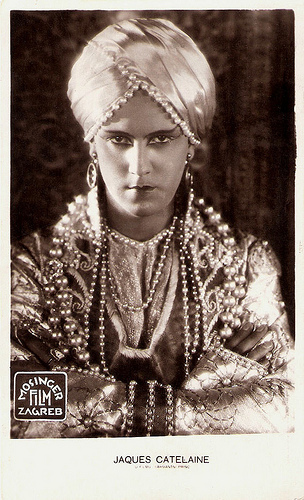
Jaque Catelain. Yugoslavian postcard by Jos. Caklovic, Zagreb, no. 75. Photo: Moslinger Film, Zagreb.
The Shark
Andrée Standard had a bigger role again in Le duel/The Duel (Jacques de Baroncelli, 1928), starring Mady Christians and Gabriel Gabrio. In Spain she appeared in La condesa María/Countess Mary (Benito Perojo, 1928) with Sandra Milowanoff. It was a coproduction with the French Albatross Studio. She also appeared in the war film Andranik (Acho Chakatouny, 1929).
Her next production was the sound film Le requin/The Shark (Henri Chomette, 1930). A ruined ship-owner (Rudolf Klein-Rogge) deliberately sinks his ship so that he can claim the insurance money. He is acquitted by the court but his wife (Gina Manès), who only just survived the disaster, takes her revenge by killing him. Le Requin was the first full length French sound film. It included several songs and dialog in the end sequences as well as a synchronized soundtrack.
Andrée Standart’s second sound film was Le train des suicides/The Train of Suicides (Edmond Gréville, 1931). Locked in a train, several willing suicides are impatiently awaiting the death that has been promised them by an unscrupulous fraudster. Just when they have all been driven almost insane with anxiety, the door is opened and a detective unmasks the criminal. It was Andrée Standart's last screen appearance.
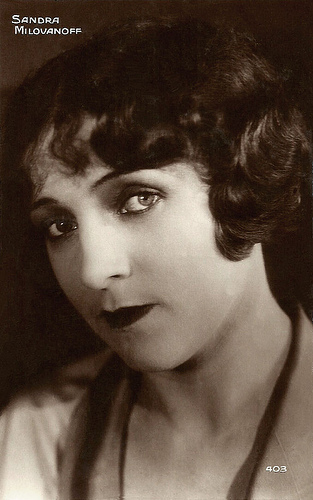
Sandra Milowanoff. French postcard by Editions Cinémagazine, no. 403.
Sources: Films de France, Wikipedia and .

French postcard by EC, no. 52. Collection: Didier Hanson.
The Queen
This card of beautiful Andrée Standard is one of the 'rares' of Didier Hanson's collection. It's the only card of her on the net and the actress seems to be completely forgotten. We could not find more information about her than her filmography. But some of her films are very interesting. She appeared both in the greatest epic of the French silent cinema and in the first French sound film.
Andrée Standart started her film career probably in Le prince charmant/Prince Charming (Victor Tourjansky, 1925) with Claude France, Nathalie Kovanko and Jaque Catelain as the Prince. That year she had a bigger role in the comedy 600000 francs par mois/600,000 francs per month (Nicolas Koline, Robert Péguy, 1925) opposite Nicolas Koline and Charles Vanel.
Standart played a queen in the comedy Titi premier, roi des gosses/Titi the first, king of the kids (René Leprince, 1926). In the historical epic Napoléon (Abel Gance, 1927), she played the minor part of Thérèse Tallien. Tallien admires beautiful Joséphine de Beauharnais (Gina Manès) at the Victim's Ball at Les Carmes, formerly the prison where Joséphine was held. She was credited now as Andrée Standard, and continued to be so in some of her following films.

Jaque Catelain. Yugoslavian postcard by Jos. Caklovic, Zagreb, no. 75. Photo: Moslinger Film, Zagreb.
The Shark
Andrée Standard had a bigger role again in Le duel/The Duel (Jacques de Baroncelli, 1928), starring Mady Christians and Gabriel Gabrio. In Spain she appeared in La condesa María/Countess Mary (Benito Perojo, 1928) with Sandra Milowanoff. It was a coproduction with the French Albatross Studio. She also appeared in the war film Andranik (Acho Chakatouny, 1929).
Her next production was the sound film Le requin/The Shark (Henri Chomette, 1930). A ruined ship-owner (Rudolf Klein-Rogge) deliberately sinks his ship so that he can claim the insurance money. He is acquitted by the court but his wife (Gina Manès), who only just survived the disaster, takes her revenge by killing him. Le Requin was the first full length French sound film. It included several songs and dialog in the end sequences as well as a synchronized soundtrack.
Andrée Standart’s second sound film was Le train des suicides/The Train of Suicides (Edmond Gréville, 1931). Locked in a train, several willing suicides are impatiently awaiting the death that has been promised them by an unscrupulous fraudster. Just when they have all been driven almost insane with anxiety, the door is opened and a detective unmasks the criminal. It was Andrée Standart's last screen appearance.

Sandra Milowanoff. French postcard by Editions Cinémagazine, no. 403.
Sources: Films de France, Wikipedia and .
Published on August 22, 2013 23:00
Andrée Standart
Andrée Standart (or Standard) appeared in silent French films of the late 1920s as well as in the first French sound production.

French postcard by EC, no. 52. Collection: Didier Hanson.
The Queen
This card of beautiful Andrée Standard is one of the 'rares' of Didier Hanson's collection. It's the only card of her on the net and the actress seems to be completely forgotten. We could not find more information about her than her filmography. But some of her films are very interesting. She appeared both in the greatest epic of the French silent cinema and in the first French sound film.
Andrée Standart started her film career probably in Le prince charmant/Prince Charming (Victor Tourjansky, 1925) with Claude France, Nathalie Kovanko and Jaque Catelain as the Prince. That year she had a bigger role in the comedy 600000 francs par mois/600,000 francs per month (Nicolas Koline, Robert Péguy, 1925) opposite Nicolas Koline and Charles Vanel.
Standart played a queen in the comedy Titi premier, roi des gosses/Titi the first, king of the kids (René Leprince, 1926). In the historical epic Napoléon (Abel Gance, 1927), she played the minor part of Thérèse Tallien. Tallien admires beautiful Joséphine de Beauharnais (Gina Manès) at the Victim's Ball at Les Carmes, formerly the prison where Joséphine was held. She was credited now as Andrée Standard, and continued to be so in some of her following films.

Jaque Catelain. Yugoslavian postcard by Jos. Caklovic, Zagreb, no. 75. Photo: Moslinger Film, Zagreb.
The Shark
Andrée Standard had a bigger role again in Le duel/The Duel (Jacques de Baroncelli, 1928), starring Mady Christians and Gabriel Gabrio. In Spain she appeared in La condesa María/Countess Mary (Benito Perojo, 1928) with Sandra Milowanoff. It was a coproduction with the French Albatross Studio. She also appeared in the war film Andranik (Acho Chakatouny, 1929).
Her next production was the sound film Le requin/The Shark (Henri Chomette, 1930). A ruined ship-owner (Rudolf Klein-Rogge) deliberately sinks his ship so that he can claim the insurance money. He is acquitted by the court but his wife (Gina Manès), who only just survived the disaster, takes her revenge by killing him. Le Requin was the first full length French sound film. It included several songs and dialog in the end sequences as well as a synchronized soundtrack.
Andrée Standart’s second sound film was Le train des suicides/The Train of Suicides (Edmond Gréville, 1931). Locked in a train, several willing suicides are impatiently awaiting the death that has been promised them by an unscrupulous fraudster. Just when they have all been driven almost insane with anxiety, the door is opened and a detective unmasks the criminal. It was Andrée Standart's last screen appearance.

Sandra Milowanoff. French postcard by Editions Cinémagazine, no. 403.
Sources: Films de France, Wikipedia and .

French postcard by EC, no. 52. Collection: Didier Hanson.
The Queen
This card of beautiful Andrée Standard is one of the 'rares' of Didier Hanson's collection. It's the only card of her on the net and the actress seems to be completely forgotten. We could not find more information about her than her filmography. But some of her films are very interesting. She appeared both in the greatest epic of the French silent cinema and in the first French sound film.
Andrée Standart started her film career probably in Le prince charmant/Prince Charming (Victor Tourjansky, 1925) with Claude France, Nathalie Kovanko and Jaque Catelain as the Prince. That year she had a bigger role in the comedy 600000 francs par mois/600,000 francs per month (Nicolas Koline, Robert Péguy, 1925) opposite Nicolas Koline and Charles Vanel.
Standart played a queen in the comedy Titi premier, roi des gosses/Titi the first, king of the kids (René Leprince, 1926). In the historical epic Napoléon (Abel Gance, 1927), she played the minor part of Thérèse Tallien. Tallien admires beautiful Joséphine de Beauharnais (Gina Manès) at the Victim's Ball at Les Carmes, formerly the prison where Joséphine was held. She was credited now as Andrée Standard, and continued to be so in some of her following films.

Jaque Catelain. Yugoslavian postcard by Jos. Caklovic, Zagreb, no. 75. Photo: Moslinger Film, Zagreb.
The Shark
Andrée Standard had a bigger role again in Le duel/The Duel (Jacques de Baroncelli, 1928), starring Mady Christians and Gabriel Gabrio. In Spain she appeared in La condesa María/Countess Mary (Benito Perojo, 1928) with Sandra Milowanoff. It was a coproduction with the French Albatross Studio. She also appeared in the war film Andranik (Acho Chakatouny, 1929).
Her next production was the sound film Le requin/The Shark (Henri Chomette, 1930). A ruined ship-owner (Rudolf Klein-Rogge) deliberately sinks his ship so that he can claim the insurance money. He is acquitted by the court but his wife (Gina Manès), who only just survived the disaster, takes her revenge by killing him. Le Requin was the first full length French sound film. It included several songs and dialog in the end sequences as well as a synchronized soundtrack.
Andrée Standart’s second sound film was Le train des suicides/The Train of Suicides (Edmond Gréville, 1931). Locked in a train, several willing suicides are impatiently awaiting the death that has been promised them by an unscrupulous fraudster. Just when they have all been driven almost insane with anxiety, the door is opened and a detective unmasks the criminal. It was Andrée Standart's last screen appearance.

Sandra Milowanoff. French postcard by Editions Cinémagazine, no. 403.
Sources: Films de France, Wikipedia and .
Published on August 22, 2013 23:00
August 21, 2013
Ricardo Rodríguez
Spanish Actor Ricardo Rodríguez appeared in several Eurowesterns of the 1960s. In Der Letze Mohikaner/The Last Tomahawk (Harald Reinl, 1965) he played the evil Magua, leader of the Huron tribesmen.

German postcard, no. 63 of 64. Photo: Constantin. Still from Der Lezte Mohikaner/The Last Tomahawk (1965). Caption: "Magua weiss, dass auch sein Ende da ist. Der alte Häuptling spricht ihm die Stammesehre ab und gewährt ihm drei Trommelwirbel Vorsprung zur Flucht. Doch Magua rührt sich nicht. Nach dem dritten Trommelwirbel stricken ihn die Pfeile der Bogenschützen nieder. Neben Unkas findet er den Tod." (Magua knows that his end is here. The old chief speaks to him from the tribal honor and grants him three drum roll lead to flee. But Magua does not move. After the third drum roll the arrows of the archers knit him down. Besides Uncas he finds death.)
Indians
We did not find any private information about Ricardo Rodríguez (also Rodrigues). He made his first film appearance as ‘8th gendarme’ in The Ceremony (Laurence Harvey, 1963), a crime drama starring Laurence Harvey and Sarah Miles.
This debut was soon followed by small roles as an Indian in Eurowesterns like the excellent Spanish western Antes llega la muerte/Hour of Death (Joaquín Luis Romero Marchent, 1964), and Aventuras del Oeste/Seven Hours of Gunfire (Joaquín Luis Romero Marchent, 1965), starring Rik van Nutter as Buffalo Bill and Adrian Hoven as Wild Bill Hickok.
Rodríguez also appeared in Dos pistolas gemelas/Two Guns for Two Twins (Rafael Romero Marchent, 1966) starring the twin Pilar and Emilia Bayona (aka Pili y Mili) and Sean Flynn. Flynn, the son of Erroll Flynn and Lily Damita, disappeared a few years later, during the Vietnam war.
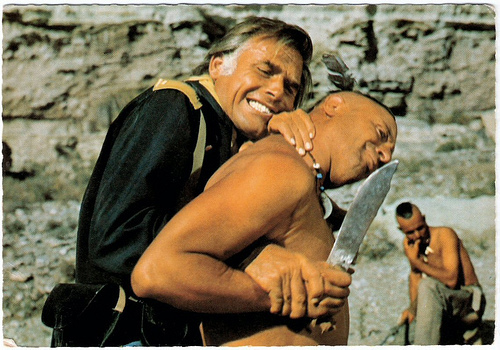
German postcard, no. 20 of 64. Photo: Constantin. Still from Der Lezte Mohikaner with Joachim Fuchsberger.

German postcard, no. 26 of 64. Photo: Constantin. Still from Der Lezte Mohikaner.
Eurospyfilm
Ricardo Rodriquez then portrayed Magua, the evil leader of the Huron tribesmen in the German-Italian-Spanish Western Der Letze Mohikaner/The Last Tomahawk (Harald Reinl, 1965), based on James Fenimore Cooper's famous novel The Last of the Mohicans. For the German version his voice was synchronized by Gerd Duwner.
Apart from the Eurowesterns, he also appeared in another popular European film genre of the 1960s, the Eurospyfilm. An example is Asso di picche operazione controspionaggio/Operation Counterspy (Nick Nostro, 1966). In the 1970s followed parts in films like La Leyenda del alcalde de Zalamea/The Legend of the Mayor of Zalamea (1973, Mario Camus) with Francisco Rabal.
Rodriquez last feature film was the hard boiled cop/jungle action pic from Sergio Leone collaborator Aldo Sambrell, La Última jugada/Last Chance (Aldo Sambrell, 1975) in which Ricardo Rodríguez was credited as Richard Roader. According to IMDb reviewer Sorsimus: "A strange mixture of euro crime cinema and jungle war... Short, fast paced and reasonably sleazy, viewed in the right frame of mind, this one should be good for a couple of laughs. The biggest shortcoming must be Sambrell's directing, which has so little regard for coherence, that the film becomes almost a surreal experience."
In 2004 Ricardo Rodríguez finally appeared in the short Historia de un destino/History of a Destiny (Diego Sanchidrián, 2004).
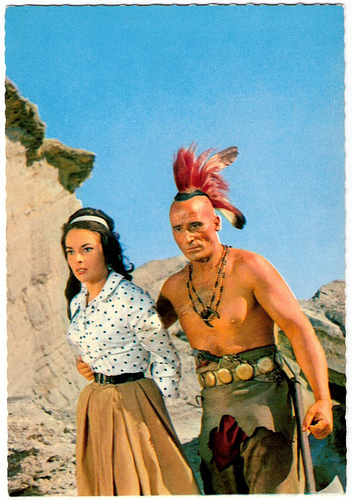
German postcard, no. 25 of 64. Photo: Constantin. Still from Der Lezte Mohikaner with Karin Dor.

German postcard, no. 57 of 64. Photo: Constantin. Still from Der Lezte Mohikaner/The Last Tomahawk (1965).
German trailer for Der Lezte Mohikaner (1965). Source: Hightower1979 (YouTube).
Sources: Wikipedia and .

German postcard, no. 63 of 64. Photo: Constantin. Still from Der Lezte Mohikaner/The Last Tomahawk (1965). Caption: "Magua weiss, dass auch sein Ende da ist. Der alte Häuptling spricht ihm die Stammesehre ab und gewährt ihm drei Trommelwirbel Vorsprung zur Flucht. Doch Magua rührt sich nicht. Nach dem dritten Trommelwirbel stricken ihn die Pfeile der Bogenschützen nieder. Neben Unkas findet er den Tod." (Magua knows that his end is here. The old chief speaks to him from the tribal honor and grants him three drum roll lead to flee. But Magua does not move. After the third drum roll the arrows of the archers knit him down. Besides Uncas he finds death.)
Indians
We did not find any private information about Ricardo Rodríguez (also Rodrigues). He made his first film appearance as ‘8th gendarme’ in The Ceremony (Laurence Harvey, 1963), a crime drama starring Laurence Harvey and Sarah Miles.
This debut was soon followed by small roles as an Indian in Eurowesterns like the excellent Spanish western Antes llega la muerte/Hour of Death (Joaquín Luis Romero Marchent, 1964), and Aventuras del Oeste/Seven Hours of Gunfire (Joaquín Luis Romero Marchent, 1965), starring Rik van Nutter as Buffalo Bill and Adrian Hoven as Wild Bill Hickok.
Rodríguez also appeared in Dos pistolas gemelas/Two Guns for Two Twins (Rafael Romero Marchent, 1966) starring the twin Pilar and Emilia Bayona (aka Pili y Mili) and Sean Flynn. Flynn, the son of Erroll Flynn and Lily Damita, disappeared a few years later, during the Vietnam war.

German postcard, no. 20 of 64. Photo: Constantin. Still from Der Lezte Mohikaner with Joachim Fuchsberger.

German postcard, no. 26 of 64. Photo: Constantin. Still from Der Lezte Mohikaner.
Eurospyfilm
Ricardo Rodriquez then portrayed Magua, the evil leader of the Huron tribesmen in the German-Italian-Spanish Western Der Letze Mohikaner/The Last Tomahawk (Harald Reinl, 1965), based on James Fenimore Cooper's famous novel The Last of the Mohicans. For the German version his voice was synchronized by Gerd Duwner.
Apart from the Eurowesterns, he also appeared in another popular European film genre of the 1960s, the Eurospyfilm. An example is Asso di picche operazione controspionaggio/Operation Counterspy (Nick Nostro, 1966). In the 1970s followed parts in films like La Leyenda del alcalde de Zalamea/The Legend of the Mayor of Zalamea (1973, Mario Camus) with Francisco Rabal.
Rodriquez last feature film was the hard boiled cop/jungle action pic from Sergio Leone collaborator Aldo Sambrell, La Última jugada/Last Chance (Aldo Sambrell, 1975) in which Ricardo Rodríguez was credited as Richard Roader. According to IMDb reviewer Sorsimus: "A strange mixture of euro crime cinema and jungle war... Short, fast paced and reasonably sleazy, viewed in the right frame of mind, this one should be good for a couple of laughs. The biggest shortcoming must be Sambrell's directing, which has so little regard for coherence, that the film becomes almost a surreal experience."
In 2004 Ricardo Rodríguez finally appeared in the short Historia de un destino/History of a Destiny (Diego Sanchidrián, 2004).

German postcard, no. 25 of 64. Photo: Constantin. Still from Der Lezte Mohikaner with Karin Dor.

German postcard, no. 57 of 64. Photo: Constantin. Still from Der Lezte Mohikaner/The Last Tomahawk (1965).
German trailer for Der Lezte Mohikaner (1965). Source: Hightower1979 (YouTube).
Sources: Wikipedia and .
Published on August 21, 2013 23:00
Paul van Yperen's Blog
- Paul van Yperen's profile
- 13 followers
Paul van Yperen isn't a Goodreads Author
(yet),
but they
do have a blog,
so here are some recent posts imported from
their feed.



